AI is a Team Sport: A Confluence of Diverse Technical and Soft Skills are Crucial for Success

Select here to download this article as a PDF.
This article covers the significance of well-rounded AI teams, including how both soft and technical skills are critical and fuel success. It’s informed by Graffius' work on AI projects as well as research and coverage from DARPA, Exceptional Agility, IBM, IEEE, Intel, MIT, Microsoft, Nvidia, Samsung, Software Engineering Institute, Stanford University, United States Artificial Intelligence Institute, and others (all listed in the bibliography section of this article).

Introduction
Artificial Intelligence (AI) has emerged as a transformative force across a growing number of industries, revolutionizing how we live, work, and interact. From autonomous vehicles and virtual assistants to personalized recommendations and medical diagnoses, AI systems have become integral to our daily lives. Behind these cutting-edge, life-changing solutions are AI teams that possess a combination of soft skills—also known as core skills, interpersonal skills, people skills, power skills, transferable skills, or transversal skills—and technical expertise.
This article highlights the synergy between soft skills and technical skills in the world of AI. While technical skills provide the general foundation for AI development, it’s the soft skills that elevate AI projects to new heights. From effective communication and critical thinking to leadership and teamwork, soft skills play a pivotal role in translating technical knowledge and capabilities into real-world applications.
The thesis of this article is that the successful development and application of AI requires a combination of soft skills and technical expertise. Technical competencies alone are not enough. Rather, it’s the combination and integration of soft and technical skills that truly unlocks the power of AI.
Next, this article focuses on the importance of soft skills in the AI landscape, highlighting how they complement and enhance technical abilities. The collaboration between these skill sets drives AI innovation.

Understanding Soft Skills in AI Teams
In the realm of AI, technical expertise often takes center stage. However, soft skills advance the successful outcomes of AI projects, as they facilitate effective communication, foster collaboration, and promote critical thinking. Soft skills are powerful facilitators of success.
Soft skills encompass a range of interpersonal and cognitive abilities that enable teams to work harmoniously, adapt to evolving challenges, and solve complex problems. In the AI landscape, where multidisciplinary teams come together to create innovative solutions, these soft skills are essential.
Effective communication stands at the forefront of soft skills in AI. AI teams must articulate complex technical concepts in a manner that is understandable to diverse stakeholders, including non-technical staff and internal or external customers/users. Clear communication promotes collaboration and ensures alignment of purpose and objectives throughout the AI development lifecycle.
Soft skills such as problem-solving and critical thinking are vital as well. AI teams frequently encounter multifaceted challenges, and it is through these soft skills that teams can identify potential bottlenecks, navigate complexities, and devise innovative solutions. By leveraging critical thinking, AI team members can evaluate different approaches, consider ethical implications, and make informed decisions that shape the development and application of AI systems.
Leadership and teamwork skills are also paramount. AI projects involve team members from diverse backgrounds, including data scientists, engineers, domain experts, designers, and others. Effective leadership enables the coordination of efforts and guides the project towards success. Similarly, teamwork skills foster an environment of trust and respect, promoting synergy among team members and enhancing overall productivity.
Recognizing the importance of soft skills in AI is crucial for fostering a balanced and effective team dynamic. It ensures that AI teams possess the interpersonal and cognitive abilities necessary to bring AI projects to fruition. The integration of soft skills alongside technical expertise sets the stage for a cohesive team capable of tackling complex AI challenges with agility and innovation.
The role of technical skills—including how they intersect with soft skills to create a powerful combination that drives success—are covered next.
The Role of Technical Skills in AI Teams
Technical skills provide the tools and knowledge required to design, build, and implement AI systems. This section explores the role that technical skills play in AI and their specific applications in various stages of AI projects.
- Programming Languages and Algorithms: Proficiency in programming languages such as Python, Java, or R is essential. These languages enable team members to write efficient code, manipulate and analyze data, and implement machine learning algorithms. Understanding algorithms, from classic ones like linear regression to cutting-edge deep learning models, empowers AI professionals to leverage mathematical principles and statistical techniques to train and optimize AI systems.
- Data Analysis and Management: AI relies on data, making data analysis and management skills crucial. AI team members need to be adept at collecting, cleaning, and preprocessing data, ensuring its quality and relevance. They must possess the knowledge of statistical methods, data visualization techniques, and data engineering practices to extract insights from complex datasets and prepare them for AI model training.
- Machine Learning and Neural Networks: Technical skills in machine learning are at the heart of AI systems. Understanding machine learning algorithms, such as decision trees, support vector machines, or convolutional neural networks, enables AI team members to create models that can learn from data and make intelligent predictions or decisions. Expertise in neural networks and deep learning architectures equips professionals with the ability to develop complex models capable of handling tasks like image recognition, natural language processing, and reinforcement learning.
- AI Frameworks and Tools: Proficiency in AI frameworks and tools (such as TensorFlow, Keras, PyTorch, Caffe, Scikit-learn, and others) are essential for building AI systems efficiently. These frameworks provide pre-built modules, libraries, and APIs that simplify the implementation of AI algorithms and models. Technical skills in utilizing these tools effectively enable AI team members to accelerate the development process, streamline model training, and optimize system performance.
- Domain Knowledge and Application-Specific Skills: Technical skills also encompass domain knowledge and application-specific expertise. Understanding the nuances of the industry or problem domain in which AI is being applied allows professionals to tailor AI solutions to meet specific requirements. For example, healthcare-focused AI projects may require knowledge of medical terminologies and regulatory considerations, while AI solutions for financial services may demand expertise in risk assessment and fraud detection.
Technical skills are essential for AI projects. They enable team members to translate concepts, theories, and algorithms into practical applications. However, technical skills alone are not sufficient for success. The collaborative nature of AI development and the need for a well-rounded AI team—including the synergy between technical skills and soft skills—is covered next.
The Power of Synergy: Soft Skills and Technical Skills in AI Teams
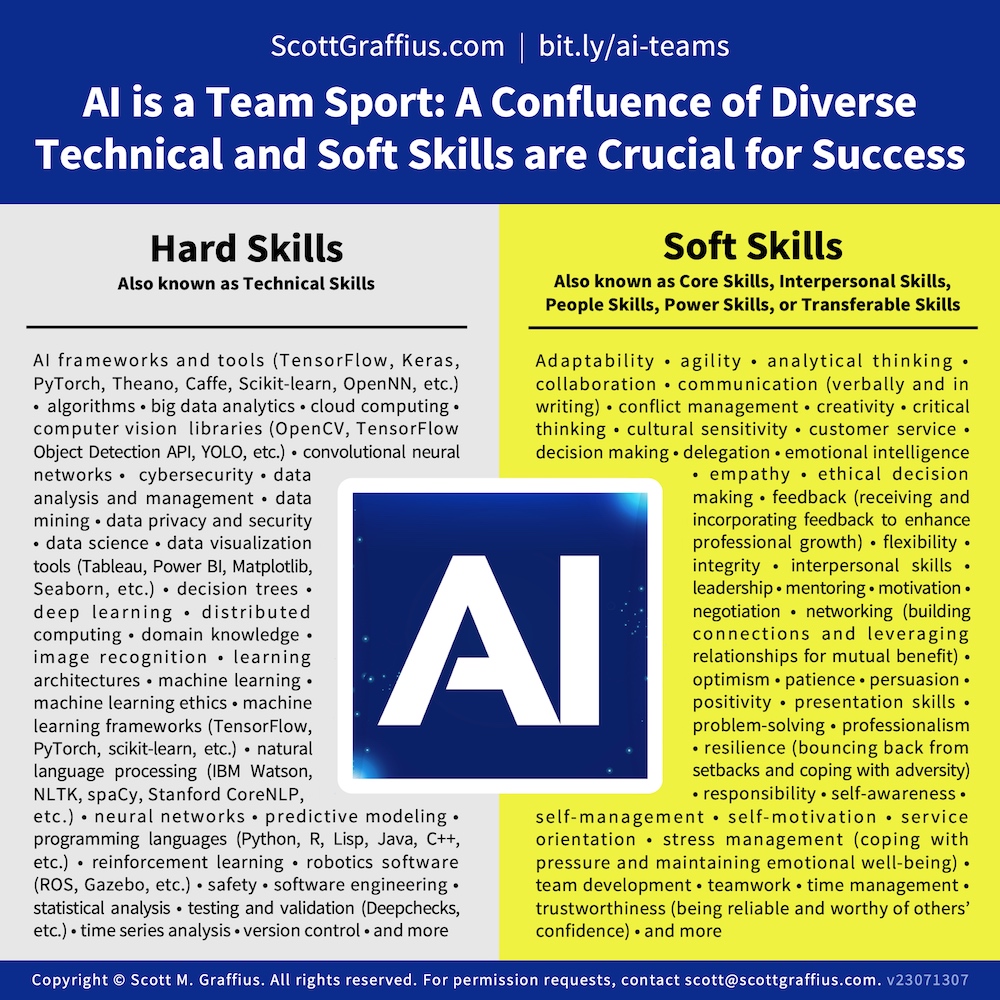
The convergence of technical and soft skills is where true innovation and breakthroughs occur. The successful development and application of AI systems rely not only on technical expertise but also on the harmonious integration of soft skills. Here’s some examples of the power of synergy between these skill sets, including how they work together to drive AI advancement:
- Effective Communication and Technical Expertise: Communication bridges the gap between AI professionals and others who may not possess technical backgrounds. AI experts with strong communication skills can articulate complex technical concepts in plain English, ensuring that everyone involved understands the goals, challenges, and progress of the project. By effectively conveying ideas, AI professionals foster collaboration, gather valuable insights, and create a shared vision for AI initiatives.
- Collaboration and Problem-Solving: Collaboration is at the core of AI development, and soft skills such as teamwork, empathy, and active listening facilitate effective collaboration among diverse team members. AI teams with strong collaboration skills can effectively pool their technical expertise, brainstorm ideas, and solve complex problems together. By leveraging their collective intelligence and diverse perspectives, AI teams can overcome challenges, refine AI models, and optimize the performance of AI solutions.
- Critical Thinking and Technical Innovation: Critical thinking, coupled with technical expertise, leads to innovative AI solutions. AI professionals with strong critical thinking skills can evaluate different approaches, challenge assumptions, and identify potential shortcomings or biases in AI models. They can think creatively to address issues such as data biases or fairness concerns, ensuring that AI systems are developed responsibly and ethically.
- Leadership and Team Empowerment: Effective leadership in AI projects involves establishing and maintaining a collaborative and inclusive environment, empowering team members, and harnessing their full potential. AI leaders with exceptional interpersonal abilities can inspire and motivate their team, foster a culture of continuous learning, and provide guidance in navigating complex technical challenges. They encourage interdisciplinary collaboration, respect diverse perspectives, and drive the team towards achieving AI objectives.
The synergy between soft skills and technical skills is the catalyst that drives AI projects towards success. It enables AI teams to go beyond technical expertise and develop AI systems that address real-world problems effectively. By embracing a holistic approach that values both soft skills and technical skills, organizations can foster an environment where AI thrives, resulting in innovative solutions that have a positive impact on society.
Strategies for developing and nurturing soft skills are covered next.
Developing and Advancing Soft Skills in AI Teams
AI teams need soft skills to be successful. Organizations and teams should prioritize the development and advancement of these skills. Here are some strategies to enhance soft skills and foster a well-rounded AI workforce:
- Training Programs and Workshops: Implement specialized training programs and workshops focused on enhancing soft skills. Offer courses in effective communication, leadership (including how to navigate the phases of team development), problem-solving, critical thinking, and collaboration. These programs can provide AI professionals with the necessary tools and techniques to effectively apply soft skills in their work.
- Interdisciplinary Collaboration and Knowledge Sharing: Encourage interdisciplinary collaboration by creating opportunities for AI team members to work alongside experts from diverse fields such as psychology, design, ethics, and business. This collaboration allows for cross-pollination of ideas, encourages different perspectives, and broadens the skill set of AI teams. Foster a culture of knowledge sharing, where professionals can learn from each other and leverage their collective experiences and expertise.
- Real-World Project Engagement: Provide AI team members with opportunities to work on (other) real-world projects, allowing them to apply their soft skills in practical scenarios. Engaging in projects that involve interaction with clients, end-users, and stakeholders helps AI team members develop effective communication, problem-solving, and teamwork skills.
- Continuous Learning and Professional Development: Encourage AI team members to engage in continuous learning and professional development activities. This can include attending conferences, participating in webinars, reading industry publications, and pursuing certifications in relevant areas. Promote a growth mindset among AI team members, emphasizing the importance of lifelong learning and staying current with the latest developments in both technical and soft skills domains.
- Mentorship and Coaching: Establish mentorship and coaching programs where experienced AI professionals guide and support individuals with less experience. Mentors can provide valuable insights, share their experiences, and offer guidance on developing skills. Regular feedback and coaching sessions help AI professionals identify areas for improvement and provide targeted development opportunities.
By implementing these strategies, organizations can cultivate a workforce that excels not only in technical skills but also in the essential soft skills required for AI success. Nurturing well-rounded AI professionals creates a collaborative and adaptive environment, where AI teams can effectively address complex challenges, drive innovation, and deliver impactful solutions.
The next section wraps up this exploration.
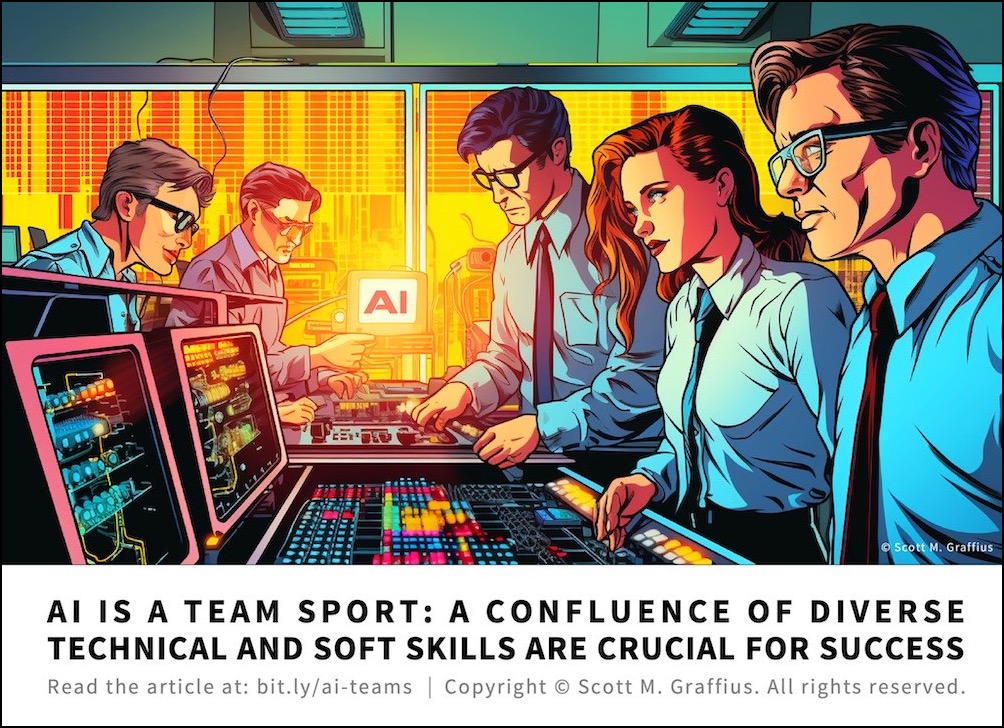

Conclusion
The successful development and application of AI systems rely on the synergy between soft skills and technical skills. While technical expertise forms the foundation, it's the integration of soft skills that elevates AI projects to new heights. Effective communication, collaboration, critical thinking, and leadership are among the key soft skills that enable AI teams to excel.
This article explored the significance of soft skills in AI, emphasizing their role in fostering effective teamwork, problem-solving, and innovation. It also acknowledged the indispensable role of technical skills in AI development, including programming languages, algorithms, data analysis, domain knowledge, and more.
Organizations can create well-rounded AI teams with a holistic set of abilities by embracing the power of synergy between soft skills and technical skills. AI team members with strong soft skills can effectively communicate their ideas, collaborate seamlessly, think critically, and provide leadership that empowers their teams.
To advance soft skills among AI professionals, organizations should invest in training programs, promote interdisciplinary collaboration, encourage continuous learning, and foster mentorship and coaching relationships. These efforts will help AI professionals develop the interpersonal and cognitive abilities necessary to thrive in the dynamic and collaborative AI landscape.
AI is a team sport that thrives on the confluence of soft skills and technical skills. By recognizing and embracing this synergy, organizations can unlock the full potential of AI, delivering innovative solutions that address real-world challenges and have a positive impact on the world.

References/Sources
All of the supplied links were functional when this article was published.
- Accenture (2023, March 30). Accenture Technology Vision 2023: Generative AI to Usher in a Bold New Future for Business, Merging Physical and Digital Worlds. Available at: https://newsroom.accenture.com/news/accenture-technology-vision-2023-generative-ai-to-usher-in-a-bold-new-future-for-business-merging-physical-and-digital-worlds.htm.
- Alsever, Jennifer (2020, January 20). Medicine by Machine: Is A.I. the Cure for the World’s Ailing Drug Industry? Fortune. Available at: https://fortune.com/longform/ai-artificial-intelligence-medicine-healthcare-pharmaceutical-industry.
- Anthropic (2023, March 14). Introducing Claude. Available at: https://www.anthropic.com/news/introducing-claude.
- Berlin School of Business and Innovation (2022, September 22). How Do Technical Abilities Combined with Leadership Skills Fuel Career Growth? Available at: https://www.berlinsbi.com/blog/career-advice/how-do-technical-abilities-combined-with-leadership-skills-fuel-career-growth.
- Bhatti, Shawaiz, Demir, Mustafa, Cooke, Nancy J., & Johnson, Craig J. (2021). Assessing Communication and Trust in an AI Teammate in a Dynamic Task Environment. In: 2021 IEEE 2nd International Conference on Human-Machine Systems (ICHMS): 1–6. DOI: 10.1109/ICHMS53169.2021.9582626.
- Brooks, David (2023, February 2). In the Age of A.I., Major in Being Human. The New York Times. Available at: https://www.nytimes.com/2023/02/02/opinion/ai-human-education.html.
- C3.ai (n.d.). Best Practices in Prototyping: Cross-Functional Teams. Available at: https://c3.ai/introduction-what-is-machine-learning/cross-functional-teams/.
- Crampton, Natasha (2021, January 19). The Building Blocks of Microsoft’s Responsible AI Program. Microsoft. Available at: https://blogs.microsoft.com/on-the-issues/2021/01/19/microsoft-responsible-ai-program.
- Dolev, Niva, & Itzkovich, Yariv (2020). In the AI Era, Soft Skills are the New Hard Skills. In: Artificial Intelligence and Its Impact on Business, pp. 55-77. Charlotte, NC: Information Age Publishing.
- Dzombak, Rachel, & Palat, Jay (2021, August 30). 5 Ways to Start Growing an AI-Ready Workforce. Pittsburgh, PA: Software Engineering Institute, Carnegie Mellon University.
- Elliott, Joshua (n.d.). Artificial Social Intelligence for Successful Teams (ASIST). Arlington, VA: Defense Advanced Research Projects Agency (DARPA).
- Exceptional Agility (2023, April 10). What's the Future of Agile? Available at: https://exceptionalagility.com/blog/files/the-future.html.
- Fountaine, Tim, McCarthy, Brian, & Saleh, Tamim (2019). Building the AI-Powered Organization. Harvard Business Review, 97 (4): 62–73.
- Gartner (2020, December 15). How to Staff Your AI Team. Available at: https://www.gartner.com/smarterwithgartner/how-to-staff-your-ai-team.
- Gong, Michelle; and Zhernov, Anton (2019, November 18). Advanced Machine Learning Helps Play Store Users Discover Personalised Apps. Google DeepMind. Available at: https://deepmind.google/discover/blog/advanced-machine-learning-helps-play-store-users-discover-personalised-apps/.
- Gorman, Austin (2023, April 27). How to Strengthen Your Soft Skills for AI and the Future of Work. Fast Company. Available at: https://www.fastcompany.com/90887540/how-to-strengthen-your-soft-skills-for-ai-and-the-future-of-work.
- GovExec Events (2020, July 1). Human Machine Team: The Intersection of Diverse Skill Sets [Video]. Defense One. Available at: https://www.youtube.com/watch?v=93wbNLKpbxg&t=1s.
- Graffius, Scott M. (2023, May 1). Fueling the Development of Innovative and Life-Changing AI Solutions [Presentation]. Talk delivered to an audience of Technology professionals (including Data Scientists, Machine Learning Engineers, Data Engineers, AI Researchers, Project Managers, Business Analysts, UX Designers, Software Developers, Cloud Architects, Data Privacy and Security Specialists, and others involved or interested in AI) at a private event in Mountain View, California, United States. Digital Object Identifier (DOI): 10.13140/RG.2.2.27956.73601. DOI link: https://dx.doi.org/10.13140/RG.2.2.27956.73601.
- Graffius, Scott M. (2023, April 26). The Science of High-Performance Teams [Presentation]. Talk delivered at the DevOps Institute’s SKILup Day 2023 Conference. Digital Object Identifier (DOI): 10.13140/RG.2.2.15888.28169. DOI link: https://dx.doi.org/10.13140/RG.2.2.15888.28169.
- Graffius, Scott M. (2023, January 9). Use the Phases of Team Development (Based on Bruce W. Tuckman's Model of Forming, Storming, Norming, Performing, and Adjourning) to Help Teams Grow and Advance: 2023 Update. Available at: https://scottgraffius.com. Digital Object Identifier (DOI): 10.13140/RG.2.2.10720.35846. DOI link: https://dx.doi.org/10.13140/RG.2.2.10720.35846.
- Graffius, Scott M. (2022, May 13). Want Happier and More Productive DevOps Teams? [Presentation]. Talk delivered at DevOpsDays Geneva, Switzerland 2022 Conference. Digital Object Identifier (DOI): 10.13140/RG.2.2.22252.85127. DOI link: https://dx.doi.org/10.13140/RG.2.2.22252.85127.
- Graffius, Scott M. (2021, October 5). Navigate the Phases of Team Development with Speed and Agility for Happier and More Productive Teams [Presentation]. Talk delivered at the Institute of Electrical and Electronics Engineers IEEE Day 2021 Conference. Digital Object Identifier (DOI): 10.13140/RG.2.2.20055.19365. DOI link: https://dx.doi.org/10.13140/RG.2.2.20055.19365.
- Graffius, Scott M. (2021, February 20). But First, the Team! [Presentation]. Talk delivered at the Brno, Czech Republic DevConf.CZ 2021 Conference. Digital Object Identifier (DOI): 10.13140/RG.2.2.29016.72964. DOI link: https://dx.doi.org/10.13140/RG.2.2.29016.72964.
- Gupta, Arun (2022). Non-Technical Skills Eat Technical Skills for Breakfast [Video]. Recording of Arun Gupta, VP and GM of the Open Ecosystem at Intel, speaking at the All Things Open Conference. Available at: https://www.youtube.com/watch?v=WNPxRBhYNU4.
- Humpton, Barbara (n.d.). The Future of Jobs. Siemens. Available at: https://www.siemens.com/us/en/company/press/siemens-stories/ceo-perspective/the-future-of-jobs.html.
- IBM (2019, September 26). Assemble the Team to Support a Data-Driven Project. Available at: https://www.ibm.com/garage/method/practices/culture/assemble-team-for-data-driven-project.
- IBM (2019). Everyday Ethics for Artificial Intelligence. Available at: https://www.ibm.com/watson/assets/duo/pdf/everydayethics.pdf.
- Institute of Electrical and Electronics Engineers (IEEE) (2021, November 8). The IEEE Global Initiative on Ethics of Autonomous and Intelligent Systems. Available at: https://standards.ieee.org/industry-connections/ec/autonomous-systems.html.
- Kenan Institute (2023, February 20). The Must-Have Skills in the Era of Artificial Intelligence: How AI’s Democratization Will Impact Workers. Available at: https://kenaninstitute.unc.edu/commentary/the-must-have-skills-in-the-era-of-artificial-intelligence-how-ais-democratization-will-impact-workers.
- Lindzon, Jared (2017, February 28). How AI is Changing the Way Companies are Organized. Fast Company. Available at: https://www.fastcompany.com/3068492/how-ai-is-changing-the-way-companies-are-organized.
- Marr, Bernard (2023, March 20). Beyond The Hype: What You Really Need to Know About AI In 2023. Forbes. Available at: https://www.forbes.com/sites/bernardmarr/2023/03/20/beyond-the-hype-what-you-really-need-to-know-about-ai-in-2023.
- Massachusetts Institute of Technology (MIT) Lincoln Laboratory (2023, January 17). Human-AI Performance Incubator. Available at: https://www.ll.mit.edu/r-d/projects/human-ai-performance-incubator.
- Massachusetts Institute of Technology (MIT) (2021, January). Cognitive Science as a New People Science for the Future of Work. Available at: https://workofthefuture.mit.edu/wp-content/uploads/2021/01/2021-Research-Brief-Polli-Kassir-Dolphin-Baker-Gabrieli.pdf.
- Massachusetts Institute of Technology (MIT) Sloan (2019, October 15). Winning With AI. MIT Sloan Management Review and Boston Consulting Group. Available at: https://sloanreview.mit.edu/projects/winning-with-ai.
- McNeese, Nathan J., Demir, Mustafa, Chiou, Erin K., & Cooke, Nancy J. (2021). Trust and Team Performance in Human–Autonomy Teaming. International Journal of Electronic Commerce, 25 (1): 51–72. DOI: 10.1080/10864415.2021.1846854.
- Mearian, Lucas (2023, February 24). Skills-Based Hiring Continues to Rise as Degree Requirements Fade. Computerworld. Available at: https://www.computerworld.com/article/3689170/skills-based-hiring-continues-to-rise-as-degree-requirements-fade.html.
- Meta (2017, October 11). Inventing the Future. Available at: https://www.meta.com/blog/quest/inventing-the-future/.
- Microsoft (2019, June 15). Is the Latest Technology the Key to Your Team’s Success, or is There Something Else? Available at: https://devblogs.microsoft.com/premier-developer/is-the-latest-technology-the-key-to-your-teams-success-or-is-there-something-else.
- New South Wales Technical and Further Education Commission (TAFE NSW) (2019). Soft vs. Hard Skills: Why Successful Australian Businesses Need Both. Ultimo, New South Wales: TAFE NSW.
- Nvidia (n.d.). Partner Innovation. Available at: https://www.nvidia.com/en-ph/self-driving-cars/partners/.
- O’Dea, Blathnaid (2023, February 17). These are the Top Skills AI and Analytics Professionals Need. Silicon Republic. Available at: https://www.siliconrepublic.com/advice/top-skills-ai-data-analytics-professionals-need.
- Olmstead, Brett (2023, February 15). Driving AI Success by Engaging a Cross-Functional Team. Available at: https://www.datarobot.com/blog/driving-ai-success-by-engaging-a-cross-functional-team/.
- Organization for Economic Cooperation and Development (OECD) (n.d.). OECD Programme on AI in Work, Innovation, Productivity and Skills. Available at: https://oecd.ai/en/work-innovation-productivity-skills/key-themes/skills.
- Oswald, Andrew. J., Proto, Eugenio, & Sgroi, Daniel (2015). Happiness and Productivity. Journal of Labor Economics, 33 (4): 789-822.
- Project Management Institute (2020, March 10). Tomorrow's Teams Today: The Future of Teaming: Creative, Collaborative and Agile. Pulse of the Profession. Available at: https://www.pmi.org/learning/library/pulse-indepth-tomorrows-teams-today-11941.
- PwC (2017). Sizing the Prize: What’s the Real Value of AI for Your Business and How Can You Capitalise? PwC’s Global Artificial Intelligence Study: Exploiting the AI Revolution. Available at: https://www.pwc.com/gx/en/issues/data-and-analytics/publications/artificial-intelligence-study.html.
- Rayside, Derek (Ed.) (2023, March 29). Software Engineering Capstone Design Project Handbook (2023 Edition). Waterloo, Ontario, Canada: University of Waterloo.
- Romsey, Joseph (2020, November 30). 5 Tips to Help Workers Upskill and Adapt to Artificial Intelligence. Society for Human Resource Management (SHRM). Available at: https://www.shrm.org/resourcesandtools/hr-topics/technology/pages/how-hr-can-help-workers-upskill-and-adapt-to-artificial-intelligence-5-tips.aspx.
- Samsung (2017, May 4). Artificial Intelligence and the Role of Workers. Available at: https://insights.samsung.com/2017/05/04/artificial-intelligence-and-the-role-of-workers/.
- Stanford University (2019, September). Gathering Strength, Gathering Storms. Stanford, CA: Stanford University.
- Tredinnick, Luke (2017). Artificial Intelligence and Professional Roles. Business Information Review, 34 (1): 37–41.
- Ungerleider, Neal (2023, January 1). AI and Jobs: The Human Angle. Available at: https://www.sap.com/denmark/insights/viewpoints/ai-jobs-human-angle.html.
- United Nations Educational, Scientific and Cultural Organization (UNESCO) (2021, July 2). AI Ethics: Another Step Closer to the Adoption of UNESCO’s Recommendation. Available at: https://en.unesco.org/news/ai-ethics-another-step-closer-adoption-unescos-recommendation-0.
- United States Artificial Intelligence Institute (USAII) (2022). Factsheet: Fast-Track Your Artificial Intelligence Career in 2023. Stamford, CT: USAII.
- United States Congress Committee on Science, Space, and Technology (2019, September 24). Artificial Intelligence and the Future of Work. Report for the One Hundred Sixteenth Congress. Available at: https://www.congress.gov/116/chrg/CHRG-116hhrg37740/CHRG-116hhrg37740.pdf.
- University of Leeds (2023, March 2). The Top 5 AI Skills You Need to Land a Job in Artificial Intelligence. Available at: https://pg-online.leeds.ac.uk/blogs/5-skills-needed-for-ai.
- World Manufacturing Foundation (2020). 2020 World Manufacturing Report: Manufacturing in the Age of Artificial Intelligence. Available at: https://worldmanufacturing.org/wp-content/uploads/WorldManufacturingForum2020_Report.pdf.

How to Cite This Article
Graffius, Scott M. (2023, May 1). AI is a Team Sport: A Confluence of Diverse Technical and Soft Skills are Crucial for Success. Available at: https://scottgraffius.com/blog/files/successful-ai-teams.html. DOI: 10.13140/RG.2.2.20321.79200.



About Scott M. Graffius

Scott M. Graffius, PMP, SA, CSP-SM, CSP-PO, CSM, CSPO, SFE, ITIL, LSSGB is an agile project management practitioner, consultant, multi-award-winning author, and international keynote speaker. He is the Founder of Exceptional PPM and PMO Solutions™ and subsidiary Exceptional Agility™. He has generated over $1.9 billion of business value in aggregate for Global Fortune 500 businesses and other organizations he has served. Graffius and content from his books, talks, workshops, and more have been featured and used by businesses, professional associations, governments, and universities. Examples include Microsoft, Oracle, Broadcom, Cisco, Gartner, Project Management Institute, IEEE, Qantas, National Academy of Sciences, United States Department of Energy, New Zealand Ministry of Education, Yale University, Tufts University, and others. He has delighted audiences with dynamic and engaging talks and workshops on agile, project management, and technology leadership at 85 conferences and other events across 25 countries.
His full bio is available here.
Connect with Scott on:
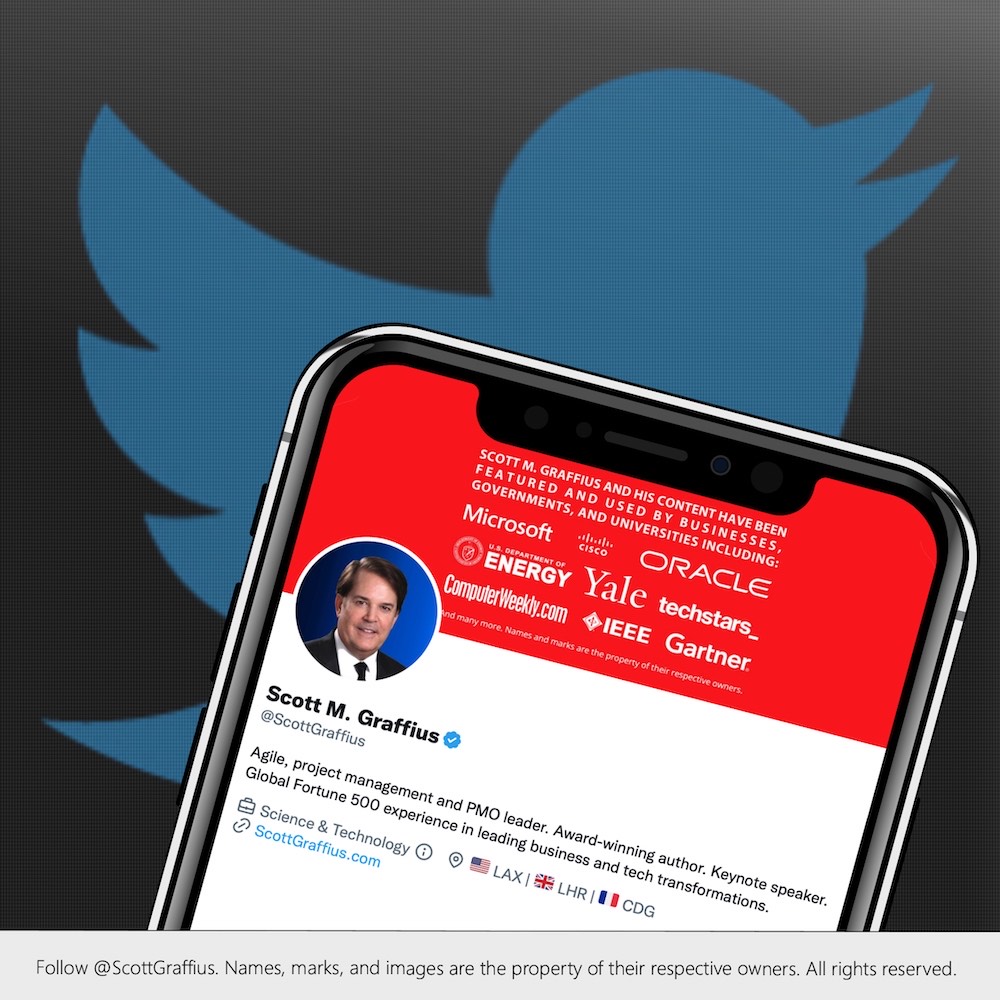

About Agile Scrum: Your Quick Start Guide with Step-by-Step Instructions
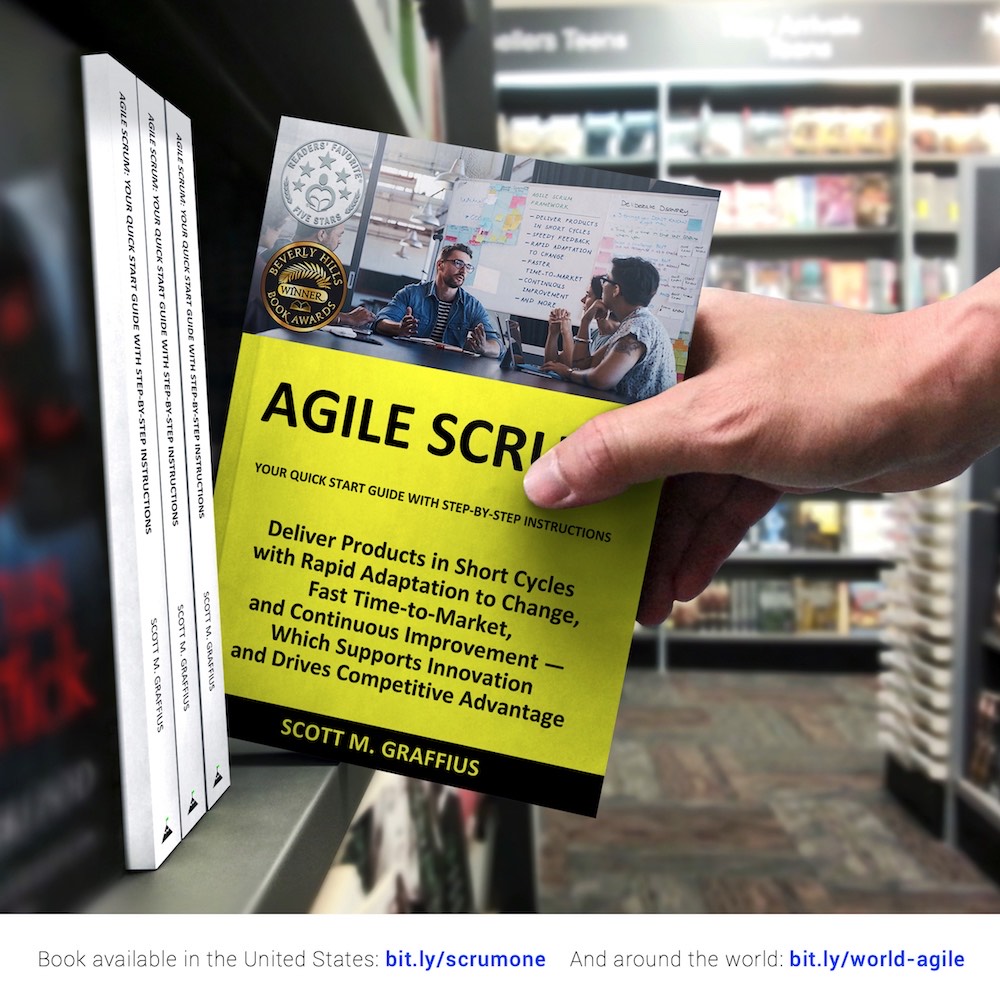
Shifting customer needs are common in today's marketplace. Businesses must be adaptive and responsive to change while delivering an exceptional customer experience to be competitive.
There are a variety of frameworks supporting the development of products and services, and most approaches fall into one of two broad categories: traditional or agile. Traditional practices such as waterfall engage sequential development, while agile involves iterative and incremental deliverables. Organizations are increasingly embracing agile to manage projects, and best meet their business needs of rapid response to change, fast delivery speed, and more.
With clear and easy to follow instructions, the multi award-winning Agile Scrum: Your Quick Start Guide with Step-by-Step Instructions book by Scott M. Graffius (Chris Hare and Colin Giffen, Technical Editors) helps the reader:
- Implement and use the most popular agile framework―Scrum;
- Deliver products in short cycles with rapid adaptation to change, fast time-to-market, and continuous improvement; and
- Support innovation and drive competitive advantage.
Hailed by Literary Titan as “the book highlights the versatility of Scrum beautifully.”
Winner of 17 first place awards.
Agile Scrum: Your Quick Start Guide with Step-by-Step Instructions is available in paperback and ebook/Kindle in the United States and around the world. Some links by country follow.
- 🇧🇷 Brazil
- 🇨🇦 Canada
- 🇨🇿 Czech Republic
- 🇩🇰 Denmark
- 🇫🇮 Finland
- 🇫🇷 France
- 🇩🇪 Germany
- 🇬🇷 Greece
- 🇭🇺 Hungary
- 🇮🇳 India
- 🇮🇪 Ireland
- 🇮🇱 Israel
- 🇮🇹 Italy
- 🇯🇵 Japan
- 🇱🇺 Luxembourg
- 🇲🇽 Mexico
- 🇳🇱 Netherlands
- 🇳🇿 New Zealand
- 🇳🇴 Norway
- 🇪🇸 Spain
- 🇸🇪 Sweden
- 🇨🇭 Switzerland
- 🇦🇪 UAE
- 🇬🇧 United Kingdom
- 🇺🇸 United States

About Agile Transformation: A Brief Story of How an Entertainment Company Developed New Capabilities and Unlocked Business Agility to Thrive in an Era of Rapid Change
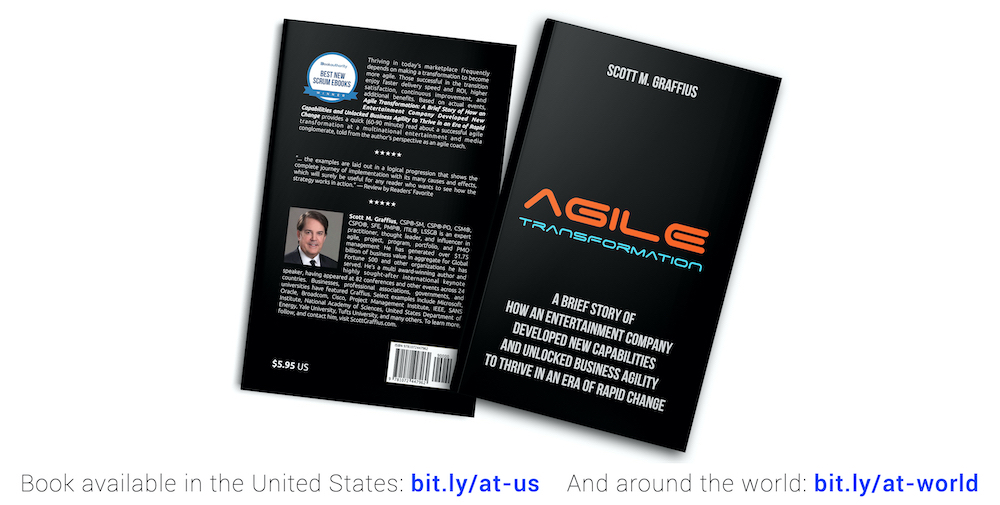
Thriving in today's marketplace frequently depends on making a transformation to become more agile. Those successful in the transition enjoy faster delivery speed and ROI, higher satisfaction, continuous improvement, and additional benefits.
Based on actual events, Agile Transformation: A Brief Story of How an Entertainment Company Developed New Capabilities and Unlocked Business Agility to Thrive in an Era of Rapid Change provides a quick (60-90 minute) read about a successful agile transformation at a multinational entertainment and media company, told from the author's perspective as an agile coach.
The award-winning book by Scott M. Graffius is available in paperback and ebook/Kindle in the United States and around the world. Some links by country follow.
- 🇦🇺 Australia
- 🇦🇹 Austria
- 🇧🇷 Brazil
- 🇨🇦 Canada
- 🇨🇿 Czech Republic
- 🇩🇰 Denmark
- 🇫🇮 Finland
- 🇫🇷 France
- 🇩🇪 Germany
- 🇬🇷 Greece
- 🇮🇳 India
- 🇮🇪 Ireland
- 🇯🇵 Japan
- 🇱🇺 Luxembourg
- 🇲🇽 Mexico
- 🇳🇱 Netherlands
- 🇳🇿 New Zealand
- 🇪🇸 Spain
- 🇸🇪 Sweden
- 🇨🇭 Switzerland
- 🇦🇪 United Arab Emirates
- 🇬🇧 United Kingdom
- 🇺🇸 United States

The short URL for this article is: https://bit.ly/ai-teams
© Copyright 2023 Scott M. Graffius. All rights reserved. This material may not be published, broadcast, rewritten or redistributed without the express written permission of Scott M. Graffius.

Scott M. Graffius Speaking at Quantum Computing Conference
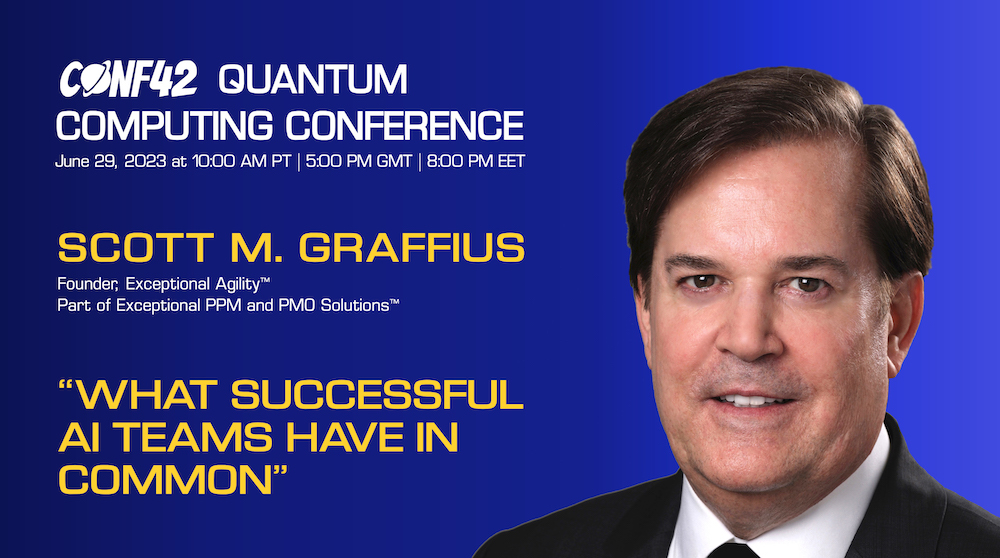
Scott M. Graffius has delivered 86 talks and workshops at conferences and other events across 25 countries. His newest engagement will be at the Conf42 Quantum Computing 2023 Conference, where he'll present “What Successful AI Teams Have in Common.” The talk draws from his work on AI projects as well as research from the Association for the Advancement of Artificial Intelligence, Google, IBM, IEEE, Microsoft, MIT, Software Engineering Institute, United States Artificial Intelligence Institute, and many others.
The conference also includes talks by:
- Daniel Goldsmith,
- Michal Jankowski,
- Trista Pan,
- Myron Giannakis,
- Peter Den Haan,
- Roberto Magnani,
- Sara Marzella, and
- Alberto García García.
Details ↴
📍 Watch the Quantum Computing Conference online
🗓 June 29, 2023 at 10:00 a.m. PT | 5:00 p.m. GMT | 8:00 p.m. EET
🎟 Subscribe to watch at: https://bit.ly/1-signup
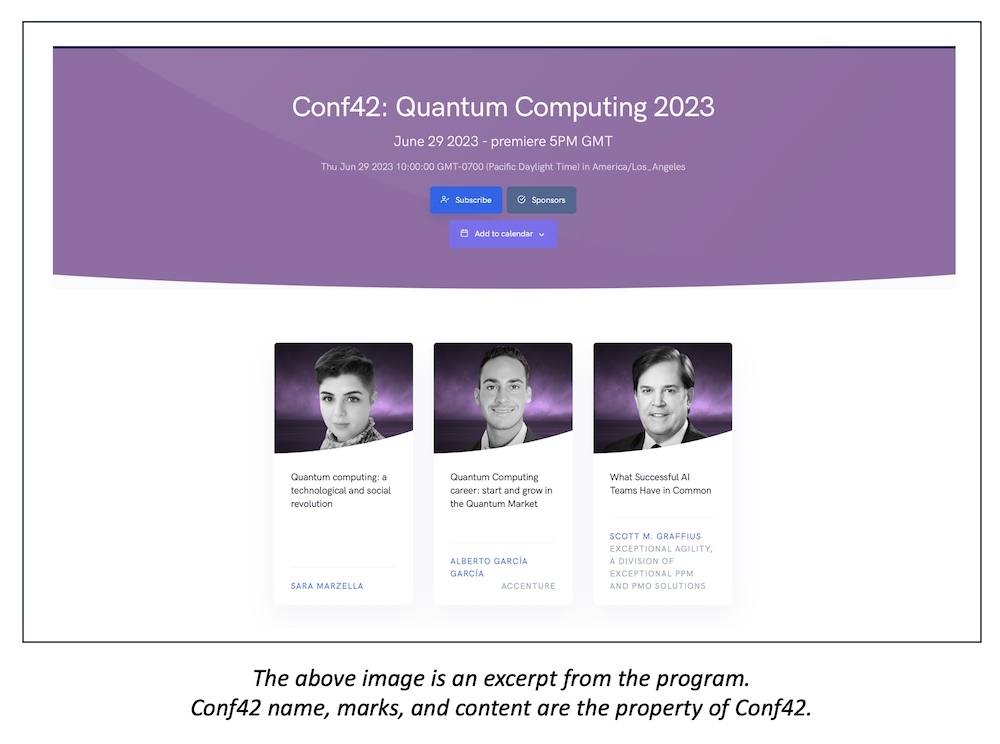



About Scott M. Graffius

Scott M. Graffius, PMP, SA, CSP-SM, CSP-PO, CSM, CSPO, SFE, ITIL, LSSGB is an agile project management practitioner, consultant, multi-award-winning author, and international keynote speaker. He is the Founder of Exceptional PPM and PMO Solutions™ and subsidiary Exceptional Agility™. He has generated over $1.9 billion of business value in aggregate for Global Fortune 500 businesses and other organizations he has served. Graffius and content from his books, talks, workshops, and more have been featured and used by businesses, professional associations, governments, and universities. Examples include Microsoft, Oracle, Broadcom, Cisco, Gartner, Project Management Institute, IEEE, Qantas, National Academy of Sciences, United States Department of Energy, New Zealand Ministry of Education, Yale University, Tufts University, and others. He has delighted audiences with dynamic and engaging talks and workshops on agile, project management, and technology (including AI) leadership at 86 conferences and other events across 25 countries.
His full bio is available here.
Connect with Scott on:


About Agile Scrum: Your Quick Start Guide with Step-by-Step Instructions

Shifting customer needs are common in today's marketplace. Businesses must be adaptive and responsive to change while delivering an exceptional customer experience to be competitive.
There are a variety of frameworks supporting the development of products and services, and most approaches fall into one of two broad categories: traditional or agile. Traditional practices such as waterfall engage sequential development, while agile involves iterative and incremental deliverables. Organizations are increasingly embracing agile to manage projects, and best meet their business needs of rapid response to change, fast delivery speed, and more.
With clear and easy to follow instructions, the multi award-winning Agile Scrum: Your Quick Start Guide with Step-by-Step Instructions book by Scott M. Graffius (Chris Hare and Colin Giffen, Technical Editors) helps the reader:
- Implement and use the most popular agile framework―Scrum;
- Deliver products in short cycles with rapid adaptation to change, fast time-to-market, and continuous improvement; and
- Support innovation and drive competitive advantage.
Hailed by Literary Titan as “the book highlights the versatility of Scrum beautifully.”
Winner of 17 first place awards.
Agile Scrum: Your Quick Start Guide with Step-by-Step Instructions is available in paperback and ebook/Kindle in the United States and around the world. Some links by country follow.
- 🇧🇷 Brazil
- 🇨🇦 Canada
- 🇨🇿 Czech Republic
- 🇩🇰 Denmark
- 🇫🇮 Finland
- 🇫🇷 France
- 🇩🇪 Germany
- 🇬🇷 Greece
- 🇭🇺 Hungary
- 🇮🇳 India
- 🇮🇪 Ireland
- 🇮🇱 Israel
- 🇮🇹 Italy
- 🇯🇵 Japan
- 🇱🇺 Luxembourg
- 🇲🇽 Mexico
- 🇳🇱 Netherlands
- 🇳🇿 New Zealand
- 🇳🇴 Norway
- 🇪🇸 Spain
- 🇸🇪 Sweden
- 🇨🇭 Switzerland
- 🇦🇪 UAE
- 🇬🇧 United Kingdom
- 🇺🇸 United States

About Agile Transformation: A Brief Story of How an Entertainment Company Developed New Capabilities and Unlocked Business Agility to Thrive in an Era of Rapid Change

Thriving in today's marketplace frequently depends on making a transformation to become more agile. Those successful in the transition enjoy faster delivery speed and ROI, higher satisfaction, continuous improvement, and additional benefits.
Based on actual events, Agile Transformation: A Brief Story of How an Entertainment Company Developed New Capabilities and Unlocked Business Agility to Thrive in an Era of Rapid Change provides a quick (60-90 minute) read about a successful agile transformation at a multinational entertainment and media company, told from the author's perspective as an agile coach.
The award-winning book by Scott M. Graffius is available in paperback and ebook/Kindle in the United States and around the world. Some links by country follow.
- 🇦🇺 Australia
- 🇦🇹 Austria
- 🇧🇷 Brazil
- 🇨🇦 Canada
- 🇨🇿 Czech Republic
- 🇩🇰 Denmark
- 🇫🇮 Finland
- 🇫🇷 France
- 🇩🇪 Germany
- 🇬🇷 Greece
- 🇮🇳 India
- 🇮🇪 Ireland
- 🇯🇵 Japan
- 🇱🇺 Luxembourg
- 🇲🇽 Mexico
- 🇳🇱 Netherlands
- 🇳🇿 New Zealand
- 🇪🇸 Spain
- 🇸🇪 Sweden
- 🇨🇭 Switzerland
- 🇦🇪 United Arab Emirates
- 🇬🇧 United Kingdom
- 🇺🇸 United States

The short URL for this article is: https://bit.ly/conf42
© Copyright 2023 Scott M. Graffius. All rights reserved. This material may not be published, broadcast, rewritten or redistributed without the express written permission of Scott M. Graffius.

Top 5 Roles on AI Teams
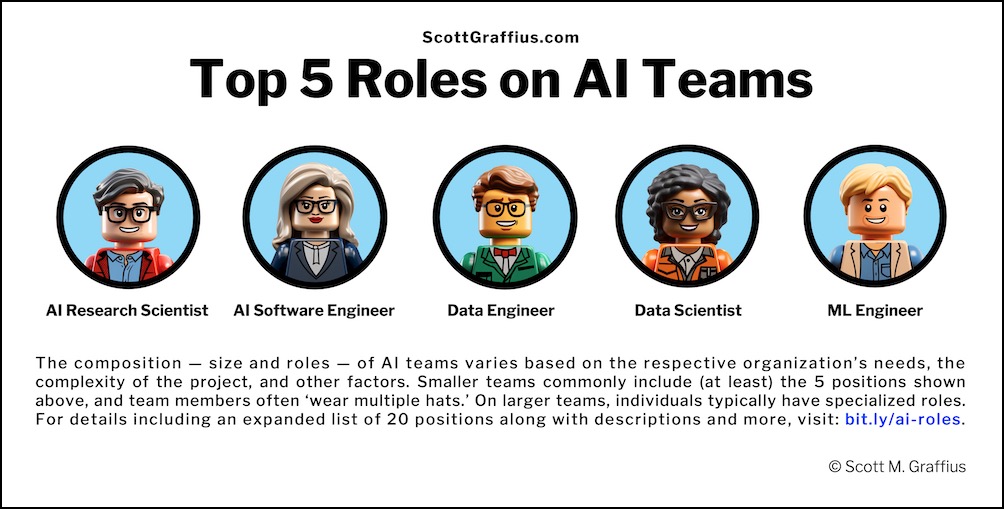
Select here to download a PDF of this article.

Effective Artificial Intelligence (AI) teams leverage critical hard skills and soft skills to develop and deliver successful AI products, including innovative solutions that address real-world challenges and have a positive impact on the world. (If you’d like to learn about the critical skills leveraged by effective AI teams, select here for our popular article on the topic.) This article focuses on the roles on AI teams.

The composition (size and roles) of AI teams varies by organization based on the respective company’s needs, the nature of the AI endeavor including complexity, and other factors. However, AI teams commonly include (at least these) five positions. Here are the five along with brief descriptions, listed in alphabetical order:
- AI Research Scientist: AI research scientists are responsible for conducting research and developing cutting-edge AI algorithms and models.
- AI Software Engineer: AI software engineers are responsible for integrating AI components into software applications. They bridge the gap between AI research and practical implementation, making AI systems usable by end-users.
- Data Engineer: Data engineers are responsible for building and managing the data pipelines that feed AI models. They ensure that data is collected, cleaned, and prepared in a format suitable for analysis and model training.
- Data Scientist: Data scientists are experts in data analysis and interpretation. They preprocess, analyze, and extract valuable insights from data, which is vital for training and improving AI models.
- Machine Learning Engineer: Machine learning engineers focus on implementing and deploying machine learning models into practical applications. They work to ensure that AI models are integrated into software systems effectively.
The above five roles collectively cover key aspects of AI development — from research and model creation to data management and software integration. Depending on requirements and characteristics (such as degree of complexity), additional positions may be needed.
An expanded list of 20 roles common to AI teams follow. Here are the aforementioned 5 and 15 additional positions, listed in alphabetical order:
- AI DevOps Engineer: Combines development and operations skills to streamline AI model deployment. They automate tasks.
- AI Ethicist: Ensures that AI systems are developed and used responsibly and ethically.
- AI Infrastructure Engineer: Builds and maintains the infrastructure required for AI model deployment and scalability.
- AI Legal and Compliance Specialist: Ensures AI projects comply with legal and regulatory requirements.
- AI Marketing Specialist: Promotes and markets AI products and solutions to customers and stakeholders.
- AI Operations (AIOps) Specialist: Focuses on the operational aspects of AI, including monitoring, maintenance, and troubleshooting.
- AI Product Manager: Oversees the development and deployment of AI products.
- AI Project Manager: Leverages general and specialized hard skills and soft skills, and applies their understanding of many aspects of artificial intelligence (such as machine learning, deep learning, automation, robotics, and natural language processing) to manage the planning, execution, and delivery of AI projects. Note: Titles vary by organization; the position may be called an AI Project Manager, AI Program Manager, Agile Project Manager, Technical Project Manager, Scrum Master, or another related designation.
- AI QA Engineer: Ensures the quality and reliability of AI models through testing and validation.
- AI Research Scientist: Conducts research to develop new AI algorithms and models.
- AI Software Engineer: Builds and maintains software systems that incorporate AI components.
- AI Trainer/Annotator: Prepares and labels data for training AI models, especially for supervised learning.
- AI UX/UI Designer: Designs user interfaces and experiences for AI-powered applications.
- Computer Vision Engineer: Specializes in developing AI models for image and video analysis.
- Data Analyst: Examines data to uncover trends and insights that can guide AI projects.
- Data Engineer: Manages data pipelines and prepares data for analysis and model training.
- Data Scientist: Analyzes and interprets data to extract insights and inform AI models.
- Deep Learning Engineer: Focuses on deep neural networks and architectures.
- Machine Learning Engineer: Focuses on implementing and deploying machine learning models.
- Natural Language Processing (NLP) Engineer: Specializes in working with text and language-related AI tasks.
The composition (size and roles) of AI teams varies, based on the complexity of the AI project and other factors. On smaller teams, individuals often ‘wear multiple hats.’ On larger teams, individuals typically have more specialized roles.

This article covered the roles common to AI teams. Listings are not exhaustive of all potential positions. Additionally, as the field of AI continues to evolve and advance, new roles may materialize to address emerging challenges and opportunities.
(If you’d like to learn about the critical skills leveraged by successful AI teams, select here for our popular article on the topic.)

References/Sources
All of the supplied links were functional when this article was published.
- Apple (n.d.). Careers at Apple: Machine Learning and AI. Available at: https://www.apple.com/careers/us/machine-learning-and-ai.html.
- C3.ai (n.d.). Best Practices in Prototyping: Cross-Functional Teams. Available at: https://c3.ai/introduction-what-is-machine-learning/cross-functional-teams/.
- Deloitte AI Institute (2021). Building Successful AI Teams. Available at: https://www2.deloitte.com/content/dam/Deloitte/us/Documents/deloitte-analytics/us-ai-institute-building-successful-AI-teams.pdf.
- Gartner (2020, December 15). Staff AI Teams with Various Roles and Skills for Success. Available at: https://www.gartner.com/smarterwithgartner/how-to-staff-your-ai-team.
- General Services Administration (GSA) Centers of Excellence (CoE) (n.d.). AI Guide for Government. Available at: https://coe.gsa.gov/coe/ai-guide-for-government/understanding-ai-job-roles-career-path/.
- Google Quantum AI (n.d.). Careers. Available at: https://quantumai.google/team/careers.
- Graffius, Scott M. (2023, May 1). AI is a Team Sport: A Confluence of Diverse Technical and Soft Skills are Crucial for Success. Available at: https://www.scottgraffius.com/blog/files/successful-ai-teams.html.
- Graffius, Scott M. (2023). What Successful AI Teams Have in Common [Video]. Graffius’ talk at the 2023 Conf42 Quantum Computer Conference. Available at: https://www.youtube.com/watch?v=u2qRKFbSKYE.
- IBM (n.d.). Assemble the Team to Support a Data-Driven Project. Available at: https://www.ibm.com/garage/method/practices/culture/assemble-team-for-data-driven-project/.
- Intel (n.d.). Artificial Intelligence Teams: Careers. Available at: https://jobs.intel.com/en/search-jobs/artificial+intelligence/599/1.
- Intuit (2020, December 8). How to avoid conflicts and delays in the AI development process (Part I). Available at: https://blogs.intuit.com/2020/12/08/how-to-avoid-conflicts-and-delays-in-the-ai-development-process-part-i/.

How to Cite This Article
Graffius, Scott M. (2023, October 9). Top 5 Roles on AI Teams. Available at: https://scottgraffius.com/blog/files/ai-team-roles.html. DOI: 10.13140/RG.2.2.34857.57449.



About Scott M. Graffius
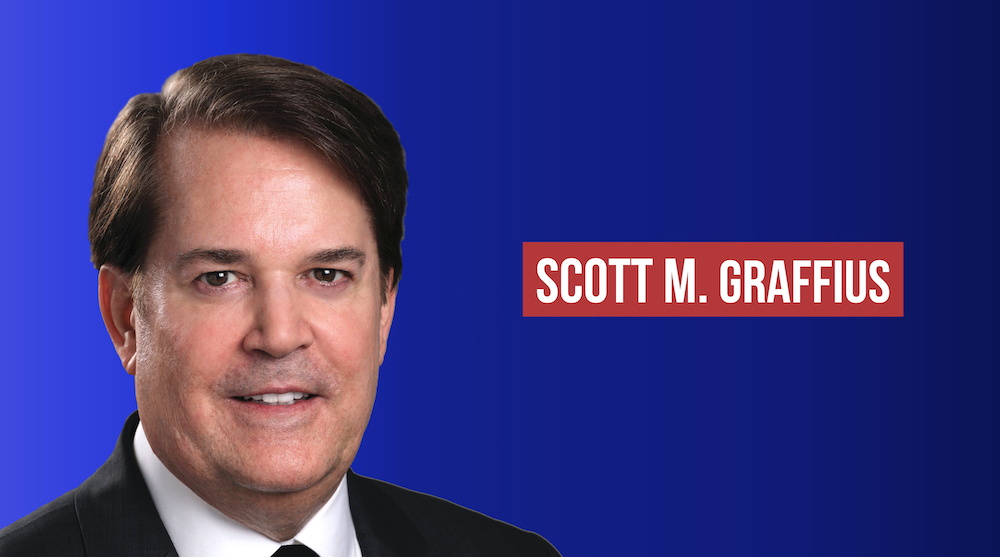
Scott M. Graffius, PMP, SA, CSP-SM, CSP-PO, CSM, CSPO, SFE, ITIL, LSSGB is an agile project management practitioner, consultant, multi-award-winning author, and international keynote speaker. He is the Founder of Exceptional PPM and PMO Solutions™ and subsidiary Exceptional Agility™. He has generated over $1.9 billion of business value in aggregate for Global Fortune 500 businesses and other organizations he has served. Graffius and content from his books, talks, workshops, and more have been featured and used by businesses, professional associations, governments, and universities. Examples include Microsoft, Oracle, Broadcom, Cisco, Gartner, Project Management Institute, IEEE, Qantas, National Academy of Sciences, United States Department of Energy, New Zealand Ministry of Education, Yale University, Tufts University, and others. He has delighted audiences with dynamic and engaging talks and workshops on agile, project management, and technology (including AI, GameDev, and more) leadership at 87 conferences and other events across 25 countries.
His full bio is available here.
Connect with Scott on:


About Agile Scrum: Your Quick Start Guide with Step-by-Step Instructions

Shifting customer needs are common in today's marketplace. Businesses must be adaptive and responsive to change while delivering an exceptional customer experience to be competitive.
There are a variety of frameworks supporting the development of products and services, and most approaches fall into one of two broad categories: traditional or agile. Traditional practices such as waterfall engage sequential development, while agile involves iterative and incremental deliverables. Organizations are increasingly embracing agile to manage projects, and best meet their business needs of rapid response to change, fast delivery speed, and more.
With clear and easy to follow instructions, the multi award-winning Agile Scrum: Your Quick Start Guide with Step-by-Step Instructions book by Scott M. Graffius (Chris Hare and Colin Giffen, Technical Editors) helps the reader:
- Implement and use the most popular agile framework―Scrum;
- Deliver products in short cycles with rapid adaptation to change, fast time-to-market, and continuous improvement; and
- Support innovation and drive competitive advantage.
Hailed by Literary Titan as “the book highlights the versatility of Scrum beautifully.”
Winner of 17 first place awards.
Agile Scrum: Your Quick Start Guide with Step-by-Step Instructions is available in paperback and ebook/Kindle in the United States and around the world. Some links by country follow.
- 🇧🇷 Brazil
- 🇨🇦 Canada
- 🇨🇿 Czech Republic
- 🇩🇰 Denmark
- 🇫🇮 Finland
- 🇫🇷 France
- 🇩🇪 Germany
- 🇬🇷 Greece
- 🇭🇺 Hungary
- 🇮🇳 India
- 🇮🇪 Ireland
- 🇮🇱 Israel
- 🇮🇹 Italy
- 🇯🇵 Japan
- 🇱🇺 Luxembourg
- 🇲🇽 Mexico
- 🇳🇱 Netherlands
- 🇳🇿 New Zealand
- 🇳🇴 Norway
- 🇪🇸 Spain
- 🇸🇪 Sweden
- 🇨🇭 Switzerland
- 🇦🇪 UAE
- 🇬🇧 United Kingdom
- 🇺🇸 United States

About Agile Transformation: A Brief Story of How an Entertainment Company Developed New Capabilities and Unlocked Business Agility to Thrive in an Era of Rapid Change

Thriving in today's marketplace frequently depends on making a transformation to become more agile. Those successful in the transition enjoy faster delivery speed and ROI, higher satisfaction, continuous improvement, and additional benefits.
Based on actual events, Agile Transformation: A Brief Story of How an Entertainment Company Developed New Capabilities and Unlocked Business Agility to Thrive in an Era of Rapid Change provides a quick (60-90 minute) read about a successful agile transformation at a multinational entertainment and media company, told from the author's perspective as an agile coach.
The award-winning book by Scott M. Graffius is available in paperback and ebook/Kindle in the United States and around the world. Some links by country follow.
- 🇦🇺 Australia
- 🇦🇹 Austria
- 🇧🇷 Brazil
- 🇨🇦 Canada
- 🇨🇿 Czech Republic
- 🇩🇰 Denmark
- 🇫🇮 Finland
- 🇫🇷 France
- 🇩🇪 Germany
- 🇬🇷 Greece
- 🇮🇳 India
- 🇮🇪 Ireland
- 🇯🇵 Japan
- 🇱🇺 Luxembourg
- 🇲🇽 Mexico
- 🇳🇱 Netherlands
- 🇳🇿 New Zealand
- 🇪🇸 Spain
- 🇸🇪 Sweden
- 🇨🇭 Switzerland
- 🇦🇪 United Arab Emirates
- 🇬🇧 United Kingdom
- 🇺🇸 United States

The short link for this article is: https://bit.ly/ai-roles.
© Copyright 2023 Scott M. Graffius. All rights reserved. This material may not be published, broadcast, rewritten or redistributed without the express written permission of Scott M. Graffius.

IEEE Xplore Publication Featured Scott M. Graffius' 'Phases of Team Development' Work

The scientific paper, “Exploring the Dynamics of Team Formation in Human-Artificial Intelligence Collaboration,” referenced and discussed Scott M. Graffius’ ‘Phases of Team Development’ work.
“Exploring the Dynamics of Team Formation in Human-Artificial Intelligence Collaboration” — a scientific paper and presentation at the 2023 International Conference on Decision Aid Sciences and Applications — referenced and discussed Graffius’ ‘Phases of Team Development.’ Here’s an excerpt: “This is evident in Graffius’ work which shows Graffius’ modifications on the phases of team development, highlighting the characteristics of Tuckman’s stages and presenting strategies to overcome their challenges.”
IEEE Xplore published the paper (here). Here’s the citation information:
Alfateh, Maryam Ali Abu; Messaadia, Mourad; and Ali, Mazen (2023, September). Exploring the Dynamics of Team Formation in Human-Artificial Intelligence Collaboration. In 2023 International Conference on Decision Aid Sciences and Applications (DASA), pp. 384-388. DOI: 10.1109/DASA59624.2023.10286788.
About Scott M. Graffius’ ‘Phases of Team Development’
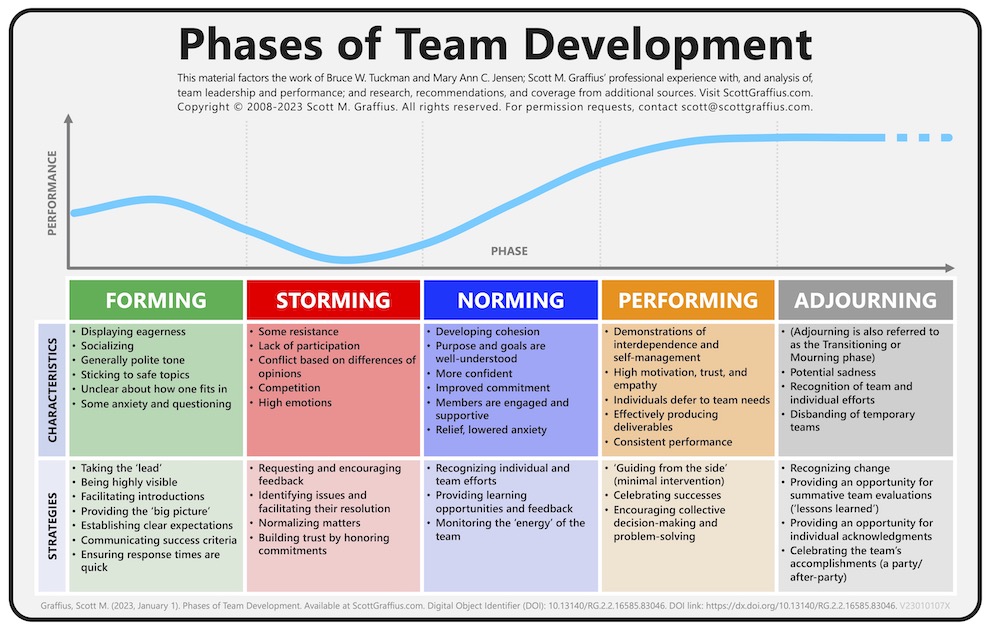
Informed by the research of Bruce W. Tuckman and Mary Ann C. Jensen, over 100 subsequent studies, and Graffius’ first-hand professional experience with, and analysis of, team leadership and performance, Graffius created his ‘Phases of Team Development’ as a unique perspective and visual conveying the five phases of team development — Forming, Storming, Norming, Performing, and Adjourning — inclusive of a graph showing how performance varies by phase, as well as the characteristics and strategies for each phase.
With permission/a license from Graffius, his ‘Phases of Team Development’ work is used by businesses, professional associations, governments, and universities around the world. Examples include Yale University, IEEE, Torrens University Australia, UK Sports Institute, Adobe, Amsterdam Public Health Research Institute, Academic Cooperation Association, Boston University, U.S. National Park Service, Bayer, Hasso Plattner Institute (Hasso-Plattner-Institut für Digital Engineering GmbH), Singapore University of Social Sciences, New Zealand Government, University of Galway Ireland, and many more.
Visit https://bit.ly/teams-23 for details, including permission request information and more.
Graffius’ ‘Phases of Team Development’ (visual and text) is copyright © Scott M. Graffius. All rights reserved.
About the IEEE
The Institute of Electrical and Electronics Engineers (IEEE) is the world’s largest professional organization advancing innovation and technological excellence for the benefit of humanity. IEEE and its members (which includes Graffius) inspire a global community to innovate for a better tomorrow through its highly cited publications, conferences, technology standards, and professional and educational activities. IEEE is the trusted “voice” for engineering, computing, and technology information around the globe. Visit https://ieee.org to learn more.
IEEE name, mark, and content are the property of the IEEE.
About IEEE Xplore
IEEE Xplore is the flagship digital platform for discovery and access to scientific and technical content published by the IEEE and its publishing partners. Visit https://innovate.ieee.org to learn more.
IEEE Xplore name, mark, and content are the property of the IEEE.



About Scott M. Graffius

Scott M. Graffius, PMP, SA, CSP-SM, CSP-PO, CSM, CSPO, SFE, ITIL, LSSGB is an agile project management practitioner, consultant, multi-award-winning author, and international keynote speaker. He is the Founder of Exceptional PPM and PMO Solutions™ and subsidiary Exceptional Agility™. He has generated over $1.9 billion of business value in aggregate for Global Fortune 500 businesses and other organizations he has served. Graffius and content from his books, talks, workshops, and more have been featured and used by businesses, professional associations, governments, and universities. Examples include Microsoft, Oracle, Broadcom, Cisco, Gartner, Project Management Institute, IEEE, Qantas, National Academy of Sciences, United States Department of Energy, New Zealand Ministry of Education, Yale University, Tufts University, and others. He has delighted audiences with dynamic and engaging talks and workshops at 88 conferences and other events across 25 countries.
His full bio is available here.
Connect with Scott on:


About Agile Scrum: Your Quick Start Guide with Step-by-Step Instructions

Shifting customer needs are common in today's marketplace. Businesses must be adaptive and responsive to change while delivering an exceptional customer experience to be competitive.
There are a variety of frameworks supporting the development of products and services, and most approaches fall into one of two broad categories: traditional or agile. Traditional practices such as waterfall engage sequential development, while agile involves iterative and incremental deliverables. Organizations are increasingly embracing agile to manage projects, and best meet their business needs of rapid response to change, fast delivery speed, and more.
With clear and easy to follow instructions, the multi award-winning Agile Scrum: Your Quick Start Guide with Step-by-Step Instructions book by Scott M. Graffius (Chris Hare and Colin Giffen, Technical Editors) helps the reader:
- Implement and use the most popular agile framework―Scrum;
- Deliver products in short cycles with rapid adaptation to change, fast time-to-market, and continuous improvement; and
- Support innovation and drive competitive advantage.
Hailed by Literary Titan as “the book highlights the versatility of Scrum beautifully.”
Winner of 17 first place awards.
Agile Scrum: Your Quick Start Guide with Step-by-Step Instructions is available in paperback and ebook/Kindle in the United States and around the world. Some links by country follow.
- 🇧🇷 Brazil
- 🇨🇦 Canada
- 🇨🇿 Czech Republic
- 🇩🇰 Denmark
- 🇫🇮 Finland
- 🇫🇷 France
- 🇩🇪 Germany
- 🇬🇷 Greece
- 🇭🇺 Hungary
- 🇮🇳 India
- 🇮🇪 Ireland
- 🇮🇱 Israel
- 🇮🇹 Italy
- 🇯🇵 Japan
- 🇱🇺 Luxembourg
- 🇲🇽 Mexico
- 🇳🇱 Netherlands
- 🇳🇿 New Zealand
- 🇳🇴 Norway
- 🇪🇸 Spain
- 🇸🇪 Sweden
- 🇨🇭 Switzerland
- 🇦🇪 UAE
- 🇬🇧 United Kingdom
- 🇺🇸 United States

About Agile Transformation: A Brief Story of How an Entertainment Company Developed New Capabilities and Unlocked Business Agility to Thrive in an Era of Rapid Change

Thriving in today's marketplace frequently depends on making a transformation to become more agile. Those successful in the transition enjoy faster delivery speed and ROI, higher satisfaction, continuous improvement, and additional benefits.
Based on actual events, Agile Transformation: A Brief Story of How an Entertainment Company Developed New Capabilities and Unlocked Business Agility to Thrive in an Era of Rapid Change provides a quick (60-90 minute) read about a successful agile transformation at a multinational entertainment and media company, told from the author's perspective as an agile coach.
The award-winning book by Scott M. Graffius is available in paperback and ebook/Kindle in the United States and around the world. Some links by country follow.
- 🇦🇺 Australia
- 🇦🇹 Austria
- 🇧🇷 Brazil
- 🇨🇦 Canada
- 🇨🇿 Czech Republic
- 🇩🇰 Denmark
- 🇫🇮 Finland
- 🇫🇷 France
- 🇩🇪 Germany
- 🇬🇷 Greece
- 🇮🇳 India
- 🇮🇪 Ireland
- 🇯🇵 Japan
- 🇱🇺 Luxembourg
- 🇲🇽 Mexico
- 🇳🇱 Netherlands
- 🇳🇿 New Zealand
- 🇪🇸 Spain
- 🇸🇪 Sweden
- 🇨🇭 Switzerland
- 🇦🇪 United Arab Emirates
- 🇬🇧 United Kingdom
- 🇺🇸 United States

© Copyright 2023 Scott M. Graffius. All rights reserved. This material may not be published, broadcast, rewritten or redistributed without the express written permission of Scott M. Graffius.

Scott M. Graffius Speaking on Successful AI at DevDays Europe 2024 Conference
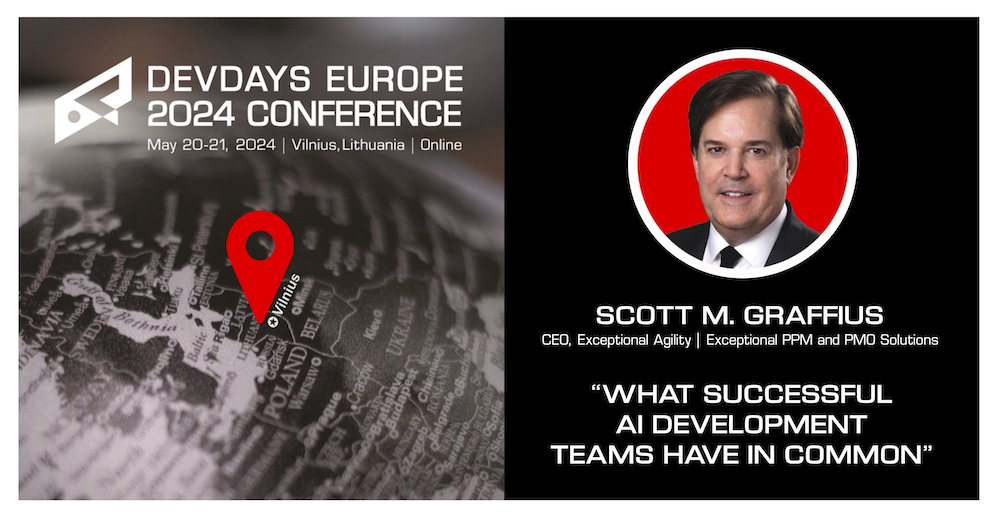
Agile leader, consultant, creator, multi-award-winning author, and international public speaker Scott M. Graffius delights audiences around the world with talks and workshops on AI, Innovation, Agile, Project Management, High Performance Teams, Video Game Development, Tech Leadership, Strategic Alignment, and more. He uses everyday language and vibrant custom visuals to make complex topics clear and understandable, and he provides audiences with practical information they can use. His sessions are highly rated by attendees and organizers alike.
Conference organizers, businesses, professional associations, government agencies, and universities around the world invite Scott to speak. He’s presented 89 talks and workshops at conferences and other events (public and private/corporate) across 25 countries.
Scott's newest engagement will be the DevDays Europe 2024 Conference, where he'll present “What Successful AI Development Teams Have in Common.” His talk draws from his work on AI projects as well as research from DARPA, Google, IBM, IEEE, Microsoft, Nvidia, Oracle, Software Engineering Institute, USAII, and other organizations.
💡 AI
ℹ️ https://bit.ly/dde2024
📍 Vilnius, Lithuania | Online
🗓 Tuesday, 21 May 2024
🕙 10:00 a.m. Eastern European Time
🎟 https://devdays.lt
About the DevDays Europe 2024 Conference
DevDays Europe brings together internationally recognized speakers and developers to encourage excellence and innovation in the software development community. The conference will cover emerging technologies and best practices in the software development industry — regardless of technological platform or language — without commercial hype. It will run from May 20-21, 23-24. Conference sessions will take place in the dynamic ambiance of movie theater halls at the Multikino Ozas (Multikino, Ozo str. 18, Vilnius, Lithuania). Visit https://devdays.lt to learn more.




About Scott M. Graffius

Scott M. Graffius, PMP, SA, CSP-SM, CSP-PO, CSM, CSPO, ITIL, LSSGB is an agile project management practitioner, consultant, thinker, creator, multi-award-winning author, and international public speaker. Founder and CEO of Exceptional PPM and PMO Solutions™ and subsidiary Exceptional Agility™, he has generated over $1.9 billion for Global Fortune 500 businesses and other organizations he has served. Graffius and content from his books, talks, workshops, and more have been featured and used by Microsoft, Oracle, Broadcom, Cisco, Gartner, Project Management Institute, IEEE, National Academy of Sciences, United States Department of Energy, Yale University, Tufts University, and others. He delights audiences with dynamic and engaging talks and workshops on agile project management, AI, Tech leadership, video game development, strategic alignment, the science of high performance teams, and more. To date, he's presented sessions at 89 conferences and other events across 25 countries.
His full bio is available here.
Connect with Scott on:
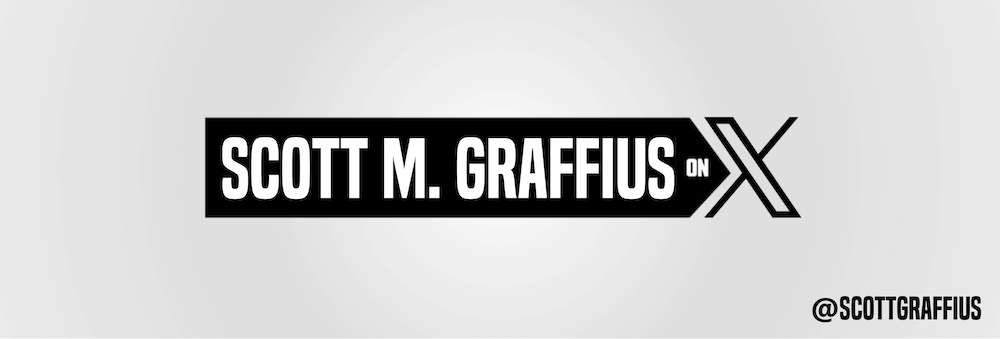
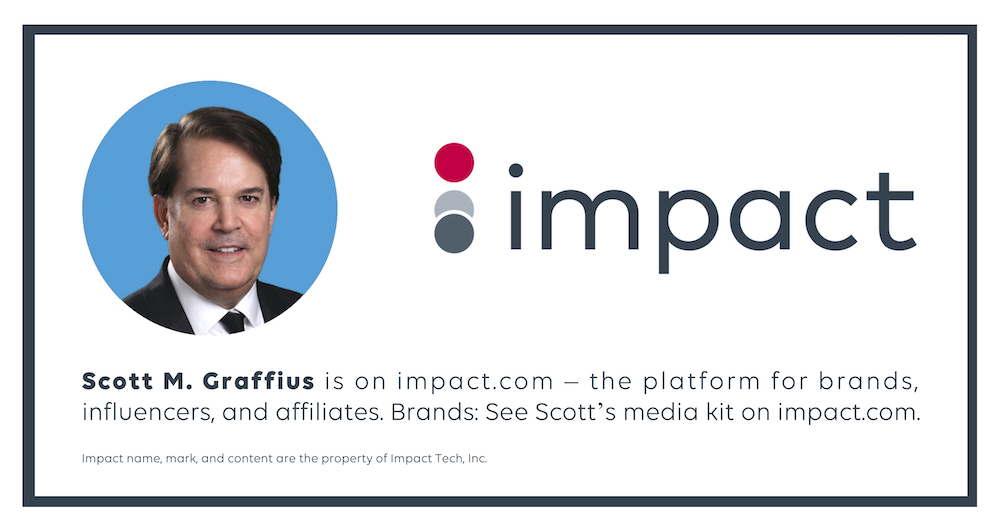

About Agile Scrum: Your Quick Start Guide with Step-by-Step Instructions

Shifting customer needs are common in today's marketplace. Businesses must be adaptive and responsive to change while delivering an exceptional customer experience to be competitive.
There are a variety of frameworks supporting the development of products and services, and most approaches fall into one of two broad categories: traditional or agile. Traditional practices such as waterfall engage sequential development, while agile involves iterative and incremental deliverables. Organizations are increasingly embracing agile to manage projects, and best meet their business needs of rapid response to change, fast delivery speed, and more.
With clear and easy to follow step-by-step instructions, Scott M. Graffius's award-winning Agile Scrum: Your Quick Start Guide with Step-by-Step Instructions helps the reader:
- Implement and use the most popular agile framework―Scrum;
- Deliver products in short cycles with rapid adaptation to change, fast time-to-market, and continuous improvement; and
- Support innovation and drive competitive advantage.
Hailed by Literary Titan as “the book highlights the versatility of Scrum beautifully.”
Winner of 17 first place awards.
Agile Scrum: Your Quick Start Guide with Step-by-Step Instructions is available in paperback and ebook/Kindle in the United States and around the world. Some links by country follow.
- 🇧🇷 Brazil
- 🇨🇦 Canada
- 🇨🇿 Czech Republic
- 🇩🇰 Denmark
- 🇫🇮 Finland
- 🇫🇷 France
- 🇩🇪 Germany
- 🇬🇷 Greece
- 🇭🇺 Hungary
- 🇮🇳 India
- 🇮🇪 Ireland
- 🇮🇱 Israel
- 🇮🇹 Italy
- 🇯🇵 Japan
- 🇱🇺 Luxembourg
- 🇲🇽 Mexico
- 🇳🇱 Netherlands
- 🇳🇿 New Zealand
- 🇳🇴 Norway
- 🇪🇸 Spain
- 🇸🇪 Sweden
- 🇨🇭 Switzerland
- 🇦🇪 UAE
- 🇬🇧 United Kingdom
- 🇺🇸 United States

About Agile Transformation: A Brief Story of How an Entertainment Company Developed New Capabilities and Unlocked Business Agility to Thrive in an Era of Rapid Change

Thriving in today's marketplace frequently depends on making a transformation to become more agile. Those successful in the transition enjoy faster delivery speed and ROI, higher satisfaction, continuous improvement, and additional benefits.
Based on actual events, Agile Transformation: A Brief Story of How an Entertainment Company Developed New Capabilities and Unlocked Business Agility to Thrive in an Era of Rapid Change provides a quick (60-90 minute) read about a successful agile transformation at a multinational entertainment and media company, told from the author's perspective as an agile coach.
The award-winning book by Scott M. Graffius is available in paperback and ebook/Kindle in the United States and around the world. Some links by country follow.
- 🇦🇺 Australia
- 🇦🇹 Austria
- 🇧🇷 Brazil
- 🇨🇦 Canada
- 🇨🇿 Czech Republic
- 🇩🇰 Denmark
- 🇫🇮 Finland
- 🇫🇷 France
- 🇩🇪 Germany
- 🇬🇷 Greece
- 🇮🇳 India
- 🇮🇪 Ireland
- 🇯🇵 Japan
- 🇱🇺 Luxembourg
- 🇲🇽 Mexico
- 🇳🇱 Netherlands
- 🇳🇿 New Zealand
- 🇪🇸 Spain
- 🇸🇪 Sweden
- 🇨🇭 Switzerland
- 🇦🇪 United Arab Emirates
- 🇬🇧 United Kingdom
- 🇺🇸 United States

Short link for this article: https://bit.ly/dev-ai
DOI: 10.13140/RG.2.2.24313.07529
© Copyright 2024 Scott M. Graffius. All rights reserved. This material may not be published, broadcast, rewritten or redistributed without the express written permission of Scott M. Graffius.

Scott M. Graffius Speaking on Agile, AI, and Innovation at a Private Event in Dubai
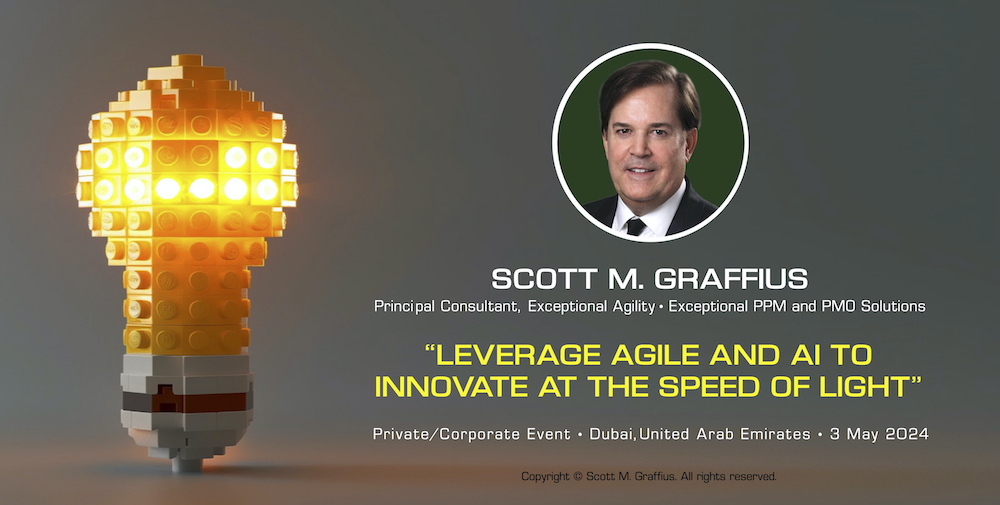

Scott M. Graffius will present "Leverage Agile and AI to Innovate at the Speed of Light" at a private/corporate event in Dubai, United Arab Emirates, on 3 May 2024. This will be his 90th speaking engagement.
Here's a short description of the session:
Agile approaches foster collaboration, responsiveness to change, and continuous improvement. And AI advances automation, efficiency, decision-making, and accuracy. Together, Agile and AI help organizations drive innovation by navigating complex landscapes with agility and precision, accelerating the pace of technological progress. Graffius' talk — "Leverage Agile and AI to Innovate at the Speed of Light" — provides unique material on the relationship between Agile and AI including how their convergence propels innovation. Most importantly, the talk provides actionable insights event delegates can use.
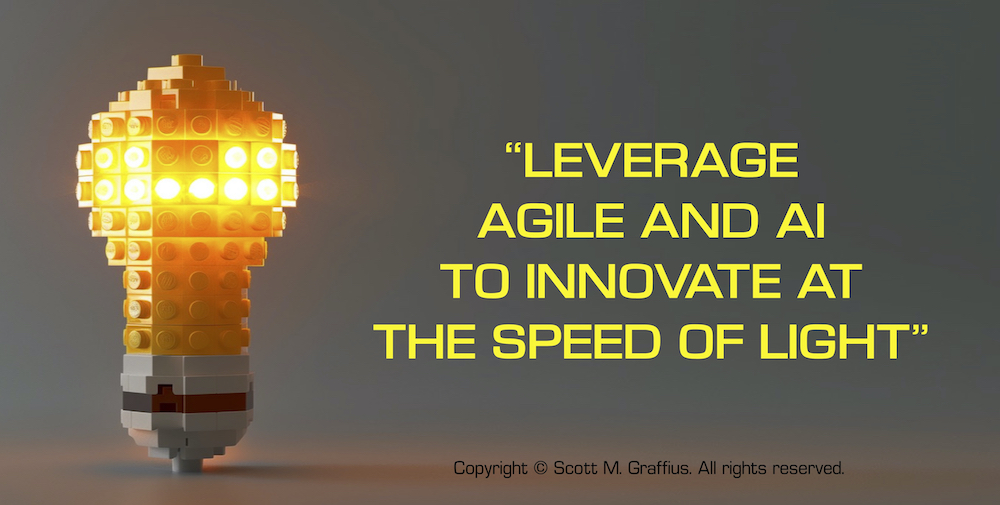
Conference organizers, businesses, professional associations, government agencies, and universities invite Graffius to speak and share actionable insights on topics related to Agile Project Management, Business, and Technology. He has delivered talks and workshops at conferences and other events — public and private/corporate — across 25 countries. Graffius uses everyday language and vibrant custom content to make complex topics clear and understandable, and he provides audiences with practical information they can use. His sessions are highly rated by attendees and organizers alike.
To learn more, visit his Public Speaker page. To book Graffius for your conference or other event — for this new session ("Leverage Agile and AI to Innovate at the Speed of Light"), one of the top five sessions (read on for details), or another topic — complete a speaker engagement request form or email him.
The five most popular talks and workshops are highlighted next.

High Performance Teams
High Performance Teams is first on the list. Scott customizes each session to the audience and other factors, so each one is unique. The following provides a general overview.
- Title: Talks or workshops on High Performance Teams may be called “Navigate the Phases of Team Development with Speed and Agility” or “Want Happier and More Productive Teams?” or another title.
- Description: Help your teams go farther, faster! Perhaps you’re heard about the phases of team development: Forming, Storming, Norming, Performing, and Adjourning. But are you aware of the unique behaviors specific to each phase? What exactly should you do during each phase to help the team (Agile or otherwise) tackle challenges, make progress, and become successful? If you are a leader (or aspire to be one), a member of a team (or may be in one in the future), or are just looking to develop your skills, this talk (with a fresh angle: 0% theory, 100% real-world-based) will give you a practical framework with actionable tips for working in and leading teams successfully. You'll learn about the five phases—Forming, Storming, Norming, Performing, and Adjourning—including detailed descriptions of each along with proven strategies for addressing challenges or issues which may occur along the way. You'll understand how to use the model to your advantage by effectively navigating all of the phases with speed and agility, from team set-up to the after-party! The presentation draws on the speaker’s first-hand, real-world experience, with his guidance supported by additional research, recommendations, and coverage from the Project Management Institute, IEEE, Google, NASA, and others.
- Key learning benefits: This talk will help you develop and enhance the contributions you make to your organization by being able to: (1) Understand the five stages of team development: Forming, Storming, Norming, Performing, and Adjourning. (2) Learn the characteristics of each phase. (3) Apply proven strategies to help handle challenges or issues experienced by the team. By doing so, you'll advance the team's happiness, productivity, and success.
- Information sheet: https://scottgraffius.com/resources/Scott-M-Graffius---Public-Speaker---Example-Session---Team-Development---v24012907.pdf.

Strategic Alignment
Strategic Alignment is second on the list of the top five topics. Scott customizes each session to the audience and other factors, so each one is unique. A general overview follows.
- Title: Talks or workshops on Strategic Alignment may be called “10 Ways to Score and Prioritize Project Proposals Based on Multiple Factors, Including Strategic Alignment” or “10 Ways to Achieve and Sustain Strategic Alignment” or another title.
- Description: How does your organization assess proposals for new projects? Is there a well-defined scoring and prioritization process—based on alignment with the business’ strategic objectives and other key factors—to quickly and easily identify the objective value of each proposal (including how important it is relative to other initiatives)? If the answer is “no,” keep reading. If the answer is “yes,” you are likely to find practical information and examples in this talk to adapt and adopt to improve the process at your organization.
- Key learning benefits: This talk will help you develop and enhance the contributions you make to your organization by being able to: (1) Understand the benefits of scoring and prioritizing project proposals based on strategic alignment and other key factors. (2) Identify selection and prioritization criteria appropriate for your unique organization, leveraging the flexible framework and some or all of the 10 factors presented during the talk. (3) Put the practical, actionable information presented to use. During the session, we will run an example project proposal through the process, step-by-step. And you will receive a summary "cheat sheet" digital download that you can reference as a guide to help implement or improve this process at your organization.
- Information sheet: https://scottgraffius.com/resources/Scott-M-Graffius---Public-Speaker---Example-Session---10-Ways-Strategic-Alignment---v24012907.pdf.

Agile
Agile is third on the list of the top five topics. Scott customizes each session to the audience and other factors, so each one is unique. A general overview follows.
- Title: Talks or workshops on Agile may be called “Are You Realizing All the Benefits from Agile?” or “Agile Scrum Helps Innovators, Disruptors, and Entrepreneurs Develop and Deliver Products at Astounding Speed Which Drives Competitive Advantage” or another title.
- Description: Organizations are increasingly embracing Agile to best meet their shifting business needs and successfully manage projects. Potential business benefits from Agile include faster delivery and ROI, rapid response to change, higher satisfaction, and continuous improvement. All of which supports innovation and helps drive competitive advantage. Are you realizing all of the benefits? This session will cover the full lifecycle of the most popular Agile approach, Scrum. You will be presented with practical information including top factors from successful implementations—based on the speaker's first-hand experience and 116 sources, including the PMI, IEEE, Google, Agile Alliance, and others—you can use to gain more benefits from Agile.
- Key learning benefits: How you will benefit: (1) Gain a high-level understanding of the Scrum framework-from vision through release. (2) Learn the roles, responsibilities, tools, and techniques unique to Scrum. (3) All of which are inclusive of top factors from successful implementations, which you can put to use to help you get more benefits from Agile.
- Information sheet: https://scottgraffius.com/resources/Scott-M-Graffius---Public-Speaker---Example-Session---Agile-Benefits---v24012907.pdf.

AI Development
Successful AI Development is fourth on the list of the top five topics. Scott customizes each session to the audience and other factors, so each one is unique. A general overview follows.
- Title: Talks or workshops on Successful AI Development may be called “What Successful AI Development Teams Have in Common” or “Fueling the Development of Innovative and Life-Changing AI Solutions” or another title.
- Description: Artificial Intelligence has emerged as a transformative force across a growing number of industries, revolutionizing how we live, work, and interact. From improved medical diagnoses to self-driving cars, and more, AI systems have become integral to our daily lives. Behind these cutting-edge, life-changing solutions are AI teams with a combination of skills. This session reveals exactly how the fusion of technical skills and soft skills within AI teams fuels the successful development of innovative and effective solutions. Informed by “In the AI era, soft skills are the new hard skills” (from Artificial Intelligence and Its Impact on Business), “Soft skills are becoming a key focus” (from Computerworld), “Don’t underestimate the power of a team dynamic – your product becomes the result of it” (from Microsoft), and “Competencies like teamwork are crucial” (from MIT), this talk also delivers a deep-dive on essential team development skills based on the science of high-performing teams. Scott’s talk draws from his work with AI development teams as well as research and coverage from the Association for the Advancement of Artificial Intelligence, Google, IBM, IEEE, Microsoft, Software Engineering Institute, and many others. The usable information can provide you, your teams, and your organization with a competitive advantage.
- Key learning benefits: How you will benefit: (1) Understand technical skills and soft skills leveraged by successful AI teams to develop innovative and effective solutions. (2) Understand the essential team development skills based on the science of high-performing teams. (3) Understand specific techniques including how to apply them to advance the happiness, productivity, and success of teams.
- Information sheet: https://scottgraffius.com/resources/Scott-M-Graffius---Public-Speaker---Example-Session---AI---v24012907.pdf.

Video Game Development
Successful Video Game Development is fifth on the list of the top five topics. Scott customizes each session to the audience and other factors, so each one is unique. A general overview follows.
- Title: Talks or workshops on Successful Video Game Development may be called “The Science of High-Performance Video Game Development Teams” or “Level-Up Your Team: Science-Backed Strategies for High-Performance Video Game Development” or another title.
- Description: Behind every great video game is a team of creative and technical wizards. Creators, storytellers, designers, artists, developers, testers, and others collaborate and leverage a diverse range of hard skills (also known as technical skills) and soft skills (also known as interpersonal skills) to craft an exceptional end-product. Of the many skills, one — a soft skill — is paramount. Activision Blizzard and other premiere developers and publishers of entertainment experiences identify teamwork as critical for the successful development of video games. Informed by Scott’s first-hand work with video game development teams as well as research and coverage from Activision Blizzard, Gameloft, International Game Developers Association, Microsoft, Rockstar Games, Sony Interactive Entertainment, Ubisoft, and others, this talk delivers a deep-dive on the essential teamwork skill based on the science of high- performing teams. The information can provide you, your teams, and your organization with a competitive advantage!
- Key learning benefits: How you will benefit: (1) Understand that a confluence of both hard skills and soft skills (notably, teamwork) are crucial. (2) Learn the five phases of team development and recognize the identifiable characteristics of each phase. (3) Learn how to apply strategies to improve teams' efficacy, happiness, and success.
- Information sheet: https://scottgraffius.com/resources/Scott-M-Graffius---Public-Speaker---Example-Session---Video-Game-Development---v24012907.pdf.
Those are the top five topics for talks and workshops.

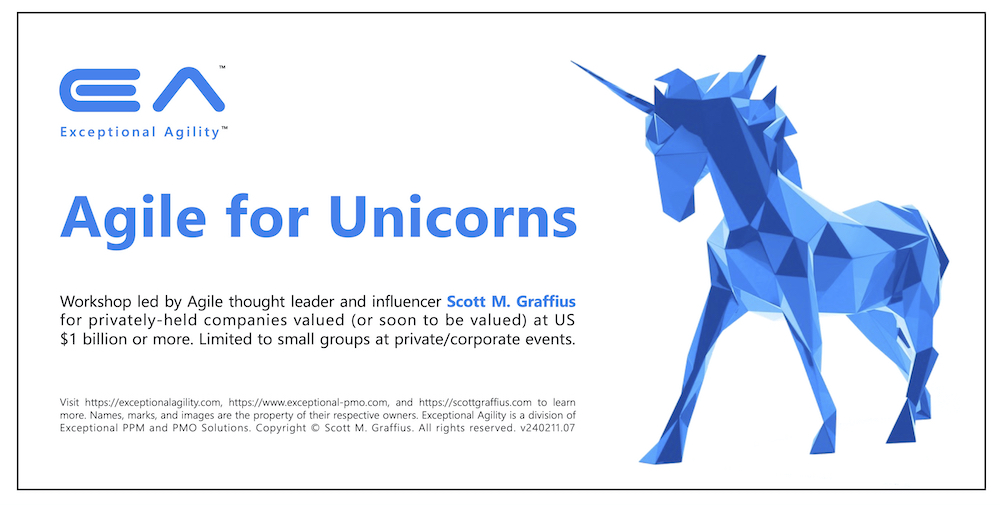
Before concluding this article, we’ll also point out a new topic which is becoming increasingly popular. It's "Agile for Unicorns." This session is for privately-held companies valued (or soon to be valued) at US $1 billion or more, and it’s limited to small groups at private/corporate events. To learn more, check out the information sheet: https://scottgraffius.com/resources/Scott-M-Graffius---Public-Speaker---Example-Session---Agile-for-Unicorns---v24012907.pdf.
Visit Scott’s Public Speaker page for a detailed listing of events, testimonials, and more.
Scott speaks around the world. To book him for your conference or other event, complete a speaker engagement request form or email him.




About Scott M. Graffius

Scott M. Graffius, PMP, SA, CSP-SM, CSP-PO, CSM, CSPO, SFE, ITIL, LSSGB is an agile project management practitioner, consultant, thinker, creator, multi-award-winning author, and international public speaker. Founder and CEO of Exceptional PPM and PMO Solutions™ and subsidiary Exceptional Agility™, he has generated over $1.9 billion for Global Fortune 500 businesses and other organizations he has served. Graffius and content from his books, talks, workshops, and more have been featured and used by Microsoft, Oracle, Broadcom, Cisco, Gartner, Project Management Institute, IEEE, National Academy of Sciences, United States Department of Energy, Yale University, Tufts University, and others. He delights audiences with dynamic and engaging talks and workshops on agile project management, AI, Tech leadership, video game development, strategic alignment, the science of high performance teams, and more. To date, he's presented sessions at 89 conferences and other events across 25 countries.
His full bio is available here.
Connect with Scott on:



About Agile Scrum: Your Quick Start Guide with Step-by-Step Instructions

Shifting customer needs are common in today's marketplace. Businesses must be adaptive and responsive to change while delivering an exceptional customer experience to be competitive.
There are a variety of frameworks supporting the development of products and services, and most approaches fall into one of two broad categories: traditional or agile. Traditional practices such as waterfall engage sequential development, while agile involves iterative and incremental deliverables. Organizations are increasingly embracing agile to manage projects, and best meet their business needs of rapid response to change, fast delivery speed, and more.
With clear and easy to follow step-by-step instructions, Scott M. Graffius's award-winning Agile Scrum: Your Quick Start Guide with Step-by-Step Instructions helps the reader:
- Implement and use the most popular agile framework―Scrum;
- Deliver products in short cycles with rapid adaptation to change, fast time-to-market, and continuous improvement; and
- Support innovation and drive competitive advantage.
Hailed by Literary Titan as “the book highlights the versatility of Scrum beautifully.”
Winner of 17 first place awards.
Agile Scrum: Your Quick Start Guide with Step-by-Step Instructions is available in paperback and ebook/Kindle in the United States and around the world. Some links by country follow.
- 🇧🇷 Brazil
- 🇨🇦 Canada
- 🇨🇿 Czech Republic
- 🇩🇰 Denmark
- 🇫🇮 Finland
- 🇫🇷 France
- 🇩🇪 Germany
- 🇬🇷 Greece
- 🇭🇺 Hungary
- 🇮🇳 India
- 🇮🇪 Ireland
- 🇮🇱 Israel
- 🇮🇹 Italy
- 🇯🇵 Japan
- 🇱🇺 Luxembourg
- 🇲🇽 Mexico
- 🇳🇱 Netherlands
- 🇳🇿 New Zealand
- 🇳🇴 Norway
- 🇪🇸 Spain
- 🇸🇪 Sweden
- 🇨🇭 Switzerland
- 🇦🇪 UAE
- 🇬🇧 United Kingdom
- 🇺🇸 United States

About Agile Transformation: A Brief Story of How an Entertainment Company Developed New Capabilities and Unlocked Business Agility to Thrive in an Era of Rapid Change

Thriving in today's marketplace frequently depends on making a transformation to become more agile. Those successful in the transition enjoy faster delivery speed and ROI, higher satisfaction, continuous improvement, and additional benefits.
Based on actual events, Agile Transformation: A Brief Story of How an Entertainment Company Developed New Capabilities and Unlocked Business Agility to Thrive in an Era of Rapid Change provides a quick (60-90 minute) read about a successful agile transformation at a multinational entertainment and media company, told from the author's perspective as an agile coach.
The award-winning book by Scott M. Graffius is available in paperback and ebook/Kindle in the United States and around the world. Some links by country follow.
- 🇦🇺 Australia
- 🇦🇹 Austria
- 🇧🇷 Brazil
- 🇨🇦 Canada
- 🇨🇿 Czech Republic
- 🇩🇰 Denmark
- 🇫🇮 Finland
- 🇫🇷 France
- 🇩🇪 Germany
- 🇬🇷 Greece
- 🇮🇳 India
- 🇮🇪 Ireland
- 🇯🇵 Japan
- 🇱🇺 Luxembourg
- 🇲🇽 Mexico
- 🇳🇱 Netherlands
- 🇳🇿 New Zealand
- 🇪🇸 Spain
- 🇸🇪 Sweden
- 🇨🇭 Switzerland
- 🇦🇪 United Arab Emirates
- 🇬🇧 United Kingdom
- 🇺🇸 United States

DOI: 10.13140/RG.2.2.30790.48960
© Copyright 2024 Scott M. Graffius. All rights reserved. This material may not be published, broadcast, rewritten or redistributed without the express written permission of Scott M. Graffius.

How Algorithms Shape the User Experience on Social Media Platforms

Introduction
More than 5.1 billion people use social media. Algorithms shape every social media interaction.
Social media platforms allow people to create, share, and exchange information and content with others. There are too many platforms to list, but eight examples include:
- Facebook,
- Instagram,
- LinkedIn,
- Pinterest,
- Snapchat,
- TikTok,
- X (formerly Twitter),
- and YouTube.
Algorithms on social media platforms are a unique set of mathematical rules and signals that determine what content to display to users, and in what order. Algorithms are both architects and gatekeepers of user experiences on the platforms.
Social media is central to many people’s daily lives. However, the platforms employ incredibly complex algorithms and they typically keep their details secret.
The impacts of algorithms are widespread and profound. They can influence opinions, shape narratives, and potentially dictate social behavior. This article reveals how algorithms shape the user experience on social media platforms. After this Introduction there are seven parts:
- From Simple to Complex (the genesis of social media algorithms),
- General Mechanics (the components of algorithms),
- Benefits and Risks (the upside and downside of algorithms),
- Algorithm-Savvy Marketing,
- Ethical Considerations,
- The Future of Algorithms on Social Media Platforms, and
- Conclusion
From Simple to Complex
Social media platforms initially relied on simple chronological feeds. However, when user engagement (such as likes, shares, and comments) exploded, platforms decided to develop and implement more sophisticated methods, principally algorithms. Then, engagement-based models shaped by algorithms took precedence. Content that users were more likely to interact with was prioritized.
The rise of artificial intelligence (AI) and machine (ML) learning has further transformed these algorithms into powerful tools. For better or worse, they are entirely capable of hyper-personalizing content which can significantly influence perceptions and decisions. AI and ML are also discussed later in this article.

General Mechanics
A complex web of data points and signals is at the core of social media algorithms. Algorithms are composed of including five fundamental components:
- User Engagement: Engagement is at the heart of algorithms. The more users interact with specific content, the more likely it is to be promoted within feeds. This initiates a cycle where popular content gains even more prominence.
- Content Prioritization: Here are examples of how different social media platforms treat content. The terms “advances,” “favors,” and “prioritizes” are used interchangeably.
- Facebook advances live videos.
- Instagram favors images and videos.
- LinkedIn prioritizes thought leadership posts.
- Pinterest advances pins about recipes, home décor, and fashion; and pins that link to external websites such as blogs.
- Snapchat prioritizes content that uses filters and lenses.
- TikTok advances videos that receive high engagement rates within seconds of being posted.
- X increasingly favors videos.
- YouTube prioritizes long videos with high watch times.
- Content Relevance: Algorithms prioritize content that aligns with users’ preferences and history. For example, if a user frequently engages with fitness-related posts, the algorithm will likely serve them with similar content. That tactic can enhance user satisfaction, but it can also lead to echo chambers. Those are environments that expose users primarily to information that reinforces their existing beliefs.
- Freshness: Social media thrives on immediacy. Newer content often takes precedence over older posts. That compels brands, influencers, and others to maintain an apt posting schedule.
- Network Effects: Content gaining traction among a user’s network helps amplify its reach by spreading (more) rapidly, including possibly ‘going viral.’ There is no universal quantification for what constitutes ‘viral,’ but a post with 1 million or more views/impressions may qualify.
Benefits and Risks
Algorithms curate content to match the preferences of individuals. That can present both benefits and risks.
Four benefits of algorithmic curation include:
- Personalization: Individuals tend to interact more frequently with content that aligns with their preferences.
- Content Discovery: Algorithms can facilitate the introduction of content and accounts that users may not have encountered otherwise.
- Reduced Information Overload: Social media platforms house a massive volume of content. Algorithms may help filter out the noise. By prioritizing relevant posts, algorithms can help individuals to focus on what matters most to them.
- Enhanced Engagement: As users find more of the content they enjoy, they will likely spend more time on the platform. This increased engagement also benefits platforms as they can monetize the increased time and attention through advertising.
Three risks of algorithmic curation include:
- Echo Chambers and Polarization: The potential formation of echo chambers is the most concerning byproduct of algorithmic personalization. Users are at risk of being shielded from differing perspectives. That is especially the case with political discourse; those situations can lead to polarization or increased polarization.
- Risk of Promoting Incorrect Information: The algorithms that prioritize engagement can potentially (by design or inadvertently) boost sensationalist content or incorrect information.
- User Fatigue: Users may experience fatigue or disillusionment when they become aware of the potential negative effects of algorithms. Users who feel that their experiences are being engineered may lose trust in the platforms, and they may stop using them.
Algorithm-Savvy Marketing
Businesses and marketers must have a good understanding of social media algorithms. Further, as the digital landscape changes over time, so must strategies. Here are six principles for navigating this complex terrain:
- Prioritize Quality Over Quantity: Create meaningful, engaging, and relevant posts.
- Engage Authentically: Engage with one’s audience in genuine ways such as through storytelling, user-generated content, and responsive interactions.
- Embrace Video Content: Use videos as platforms are increasingly prioritizing that content.
- Stay Informed: Marketers should be on the lookout for changes and be responsive to them.
- Leverage Data Analytics: Informed by metrics, marketers can adjust their strategies when needed.
- Experiment and Adapt: Platforms are continuously changing. Users’ tastes may change as well. Marketers should experiment with different content types, posting schedules, and engagement tactics to discover what works best for their audience.
Ethical Considerations
Algorithms shape user experiences, and that power carries significant responsibility. Here are four key ethical points and questions:
- Transparency: Users deserve to understand how their data is used and how content is prioritized. Increased transparency can foster trust between users and platforms. Is the social media platform transparent about how its algorithm works.
- Algorithmic Bias: Algorithms are not immune to bias as they often reflect the prejudices in the data they analyze. Is the social media platform taking steps to remove bias wherever possible?
- Content Moderation: What role, if any, should platforms play in moderating content?
- User Well-Being: Is the platform primarily focused on providing a great user experience? Or is it about doing anything and everything possible to generate time on the platform and obtain a presumed corresponding increase in revenue?
The Future of Social Media Algorithms
The future of social media algorithms is certain to be exciting and daunting. Several trends are emerging. They may impact the future of algorithms in the following five ways:
- Increased Use of AI and ML: AI and ML will continue to play a role in refining algorithms. As the technologies advance, algorithms will become even more adept at understanding user preferences and predicting behavior.
- Greater Focus on User Control: Users are becoming more aware of their data and how it’s used. Platforms may offer control to users, allowing users to customize their feeds and manage their engagement preferences.
- Ethical Algorithm Design: Ethical frameworks that prioritize user well-being, transparency, and accountability may gain prominence in the future.
- Integration of AR and VR: Social media platforms may incorporate augmented reality (AR) and virtual reality (VR) elements into their algorithms in the future. If that happens, the result will be immersive user experiences that transcend traditional content consumption.
- Community-Centric Algorithms: Algorithms in the future may prioritize community engagement and collective interests.
Conclusion
Each algorithm is a complex set of mathematical rules and signals that determine what content to display to users, and in what order. That gives them the ability to empower or manipulate users. Simply put, algorithms have a big impact on user experiences on social media platforms. It’s suggested that users advocate for ethical, user-centric design in the development and deployment of these algorithms as well as user control and transparency. When platforms adopt those measures, users will have a better experience.
For the references, how to cite this article, information about the author and more, continue reading.


References/Sources
- Adobe (2023, September 8). Guide to Beating Social Media Algorithms. Available at: https://creativecloud.adobe.com/learn/express/web/increase-social-media-visibility.
- Alalwan, A. A. (2018). Investigating the Impact of Social Media Advertising Features on Customer Purchase Intention. International Journal of Information Management, 42: 65–77. DOI: https://doi.org/10.1016/j.ijinfomgt.2018.06.001.
- Allen, R., & Choudhury, P. (2022). Algorithm-Augmented Work and Domain Experience: The Countervailing Forces of Ability and Aversion. Organization Science, 33 (1): 149-169.
- Ananny, M. (2016). Toward an Ethics of Algorithms: Convening, Observation, Probability, and Timeliness. Science, Technology, and Human Values, 41(1): 93-117. DOI: https://doi.org/10.1177/0162243915606523.
- Bensley, Robert J., & Brookins-Fisher, Jodi (2023, December 14). Community and Public Health Education Methods: A Practical Guide—Fifth Edition. Burlington, MA: Jones & Bartlett Learning.
- Berberich, N., Nishida, T., & Suzuki, S. (2020). Harmonizing Artificial Intelligence for Social Good. Philosophy and Technology, 33: 613-638.
- Berkessel, Juergen (2021, October 27). How Evergreen Posting on Social Media for Podcasters Creates Growth. Season 1, Episode 9 of the Podcasting Strategy Show. Available at: https://polymash.com/evergreen-posting.
- Burton, Taylor (2022, November 2). Social Media Marketing: Leveraging LinkedIn. Pennsylvania Bar Institute. Available at: https://go.pbi.org/blog/social-media-marketing-leveraging-linkedin.
- Center for Direct Marketing (2022, September 27). What Is the Average Lifespan of a Blog or Social Media Post? Available at: https://dmcenter.com/lifespan-of-a-post.
- Cleland, C.E. (2001). Recipes, Algorithms, Programs. Minds and Machines, 11: 219-237.
- Colicev, Anatoli, & Malshe, Ashwin, & Pauwels, Koen, & O'Connor, Peter (2018). Improving Consumer Mindset Metrics and Shareholder Value Through Social Media: The Different Roles of Owned and Earned Media. Journal of Marketing, 82 (1): 37-56.
- Confederation of European Waste-to-Energy Plants (CEWEP) (2023, June 15). The Power of Social Media and How to Use It. 10th CEWEP Waste-to-Energy Congress, 14th - 16th June 2023, Berlin. Available at: https://www.cewep.eu/congress2023presentations/ and https://www.cewep.eu/wp-content/uploads/2023/06/4.1-Monika-Michalska.pdf.
- Degraux, Xavier (2022, November 5). Quelle est la Durée d’un Post sur Twitter, Instagram, LinkedIn. Available at: https://www.xavierdegraux.be/quelle-est-la-duree-dun-post-sur-twitter-instagram-linkedin.
- Encompass Online Marketing (2023, March 15). How Often Should You Publish New Content? Available at: https://encompassonline.ca/blog/how-often-should-you-publish-new-content.
- Expand My Business (2024, January 11). How to Leverage User Experience: UX in Digital Marketing. Available at: https://blog.emb.global/ux-in-digital-marketing/.
- Frau-Meigs, Divina.(2024, June). Algorithm Literacy as a Subset of Media and Information Literacy: Competences and Design Considerations. Digital, 4: 512-528. DOI: 10.3390/digital4020026.
- Graffius, Scott M. (2023, May 1). Fueling the Development of Innovative and Life-Changing AI Solutions [Presentation]. Talk delivered to an audience of Technology professionals (including Data Scientists, Machine Learning Engineers, Data Engineers, AI Researchers, Project Managers, Business Analysts, UX Designers, Software Developers, Cloud Architects, Data Privacy and Security Specialists, and others involved or interested in AI) at a private event in Mountain View, California, United States. Digital Object Identifier (DOI): 10.13140/RG.2.2.27956.73601. DOI link: https://dx.doi.org/10.13140/RG.2.2.27956.73601.
- Graffius, Scott M. (2024, January 1). Lifespan (Half-Life) of Social Media Posts: Update for 2024. Available at: https://scottgraffius.com/blog/files/social-24.html. DOI: 10.13140/RG.2.2.21043.60965.
- Grandinetti, J. (2021). Examining embedded apparatuses of AI in Facebook and TikTok. AI and Society, 38: 1273-1286. DOI: https://doi.org/10.1007/s00146-021-01270-5.
- Hill, R.K. (2013). What an Algorithm Is, and Is Not. Communications of the ACM, 56 (6): 8-9. DOI: 10.1145/2461256.2461260.
- IBM (n.d.). What Is Social Media Analytics. Available at: https://www.ibm.com/topics/social-media-analytics.
- John, Vanessa (2024, September 5). Website vs. Social Media - Do You Still Need a Site in 2024? Madgicx. Available at: https://madgicx.com/blog/website-and-social-media.
- Jwaniat, M. A. (2023). Examining Journalistic Practices in Online Newspapers in the Era of Artificial Intelligence. 2023 International Conference on Intelligent Computing, Communication, Networking and Services (ICCNS), Valencia, Spain, 2023, pp. 183-189, DOI: 10.1109/ICCNS58795.2023.10193607.
- Keller, J., Herrmann-Schwarz, T., Roitzheim, C., Mertens, L., Christin Brockmeier, L., & Kumar Purohit, A. (2024). A Digital Nudge-Based Intervention to Interrupt Instagram Usage: Randomized Controlled Pilot Study. European Journal of Health Psychology. DOI: https://dx.doi.org/10.1027/2512-8442/a000150.
- Lang, Kirsti (2023, November 6). Decoding the Facebook Algorithm in 2024: Everything You Need to Know. Available at: https://buffer.com/library/facebook-news-feed-algorithm/.
- Lin, Yunduan, & Wang, Mengxin, & Zhang, Heng, & Zhang, Renyu, & Shen, Zuo-Jun Max (2021, June 9; revised 2023, June 28). Content Promotion for Online Content Platforms with the Diffusion Effect. SSRN. Available at: https://papers.ssrn.com/sol3/papers.cfm?abstract_id=3863104 and https://dx.doi.org/10.2139/ssrn.3863104.
- Mahesh, B. (2020). Machine Learning Algorithms—A Review. International Journal of Science and Research (IJSR), 9 (1): 381-386. https://doi.org/10.21275/art20203995.
- Metzler, H., & Garcia, D. (2024). Social Drivers and Algorithmic Mechanisms on Digital Media. Perspectives on Psychological Science, 19 (5): 735-748. DOI: https://doi.org/10.1177/17456916231185057.
- Mosseri, Adam (2023, May 31). Instagram Ranking Explained. Available at: https://about.instagram.com/blog/announcements/instagram-ranking-explained/.
- Mosseri, Adam (2021, June 8). Shedding More Light on How Instagram Works. Available at: https://about.instagram.com/blog/announcements/shedding-more-light-on-how-instagram-works.
- Newberry, Christina (2023, October 25). How Does the LinkedIn Algorithm Work? [2024 Changes Explained]. Available at: https://blog.hootsuite.com/how-the-linkedin-algorithm-works-hacks/.
- Oladipo, Tamilore (2024, January 11). A 2024 Guide to the YouTube Algorithm: Everything You Need to Know to Boost Your Content. Available at: https://buffer.com/resources/youtube-algorithm/.
- Perreault, Marie-Catherine, & Mosconi, Elaine (2018). Social Media Engagement: Content Strategy and Metrics Research Opportunities. Proceedings of the 51st Hawaii International Conference on System Sciences: 3568-3577.
- Pinterest (2023, February 22). A More Positive Internet? It’s Possible. Available at: https://business.pinterest.com/blog/a-better-internet-is-possible/.
- Pugalia, Akash, & Lalani, Farah (2023, September 29). Digital Safety: How a Multi-Faceted Approach Can Help Tackle Real-World Harm. World Economic Forum. Available at: https://www.weforum.org/agenda/2023/09/digital-safety-multi-faceted-approach-tackle-real-world-harm.
- Rainey, Clint (2023, August 15). Social Media’s Toxic Impact Can Last Up to 8 Days. This Behavioral Scientist’s Solution Might Surprise You. Available at: https://www.fastcompany.com/90939081/social-media-toxic-impact-content-moderation-solution-behavior-science.
- Roberts, J. A., & David, M. E. (2020). The Social Media Party: Fear of Missing Out (FOMO), Social Media Intensity, Connection, and Well-Being. International Journal of Human-Computer Interaction, 36 (4): 386-392.
- Rynek Pro (2023, June 26). Długość Życia Postów (Half-Life) w Mediach Społecznościowych w 2023 Roku. Available at: https://rynek.pro/half-life-dlugosc-zycia-postow/#pll_switcher.
- Schaffer, Neal (2024). Maximizing LinkedIn for Business Growth: A Practical Guide to Building Your Brand and Driving Results. Irvine, California: PDCA Social.
- Schneider, Philipp J., & Rizoiu, Marian-Andrei (2023, August 22). The Effectiveness of Moderating Harmful Online Content. Proceedings of the National Academy of Sciences of the United States of America, 120 (34): e2307360120. Available at: https://www.pnas.org/doi/abs/10.1073/pnas.2307360120. DOI: 10.1073/pnas.2307360120.
- Snapchat (n.d.). How We Rank Content on Spotlight. Available at: https://help.snapchat.com/hc/en-us/articles/8961653169940--How-We-Rank-Content-on-Spotlight.
- Statista (2024, August 19). Number of Internet and Social Media Users Worldwide as of July 2024. Available at: https://www.statista.com/statistics/617136/digital-population-worldwide/.
- Stokel-Walker, Chris (2024, March 21). TikTok’s Algorithm has Always Been a Black Box. But Researchers are Finally Figuring It Out. Fast Company. Available at: https://www.fastcompany.com/91065874/researchers-are-finally-figuring-out-how-tiktoks-algorithm-works.
- Tropp, J., & Baetzgen, A. (2019). Users’ Definition of Snapchat Usage. Implications for Marketing on Snapchat. International Journal on Media Management, 21 (2): 130-156. DOI: https://doi.org/10.1080/14241277.2019.1637343.
- X.com (2023, March 31). Twitter's Recommendation Algorithm. Available at: https://blog.x.com/engineering/en_us/topics/open-source/2023/twitter-recommendation-algorithm.
- Yunduan Lin, Mengxin Wang, Heng Zhang, Renyu Zhang, Zuo-Jun Max Shen (2024). Content Promotion for Online Content Platforms with the Diffusion Effect. Manufacturing and Service Operations Management, 26 (3):1062-1081. DOI: https://doi.org/10.1287/msom.2022.0172.
- Zhao, Junqi, & Li, Peiyuan. (2024, July). Randomized Algorithm: An Advanced Algorithm for Modern Video Games. Theoretical and Natural Science, 43: 168-183. DOI: 10.54254/2753-8818/43/20240856.
- Zuckerberg, M. (2021). Hearing Before the United States House of Representatives Committee on Energy and Commerce Subcommittees on Consumer Protection & Commerce and Communications & Technology: Testimony of Mark Zuckerberg. Available at: https://docs.house.gov/meetings/IF/IF16/20210325/111407/HHRG-117-IF16-Wstate-ZuckerbergM-20210325-U1.pdf.


How to Cite this Article
Graffius, Scott M. (2024, September 26). How Algorithms Shape the User Experience on Social Media Platforms. Available at: https://scottgraffius.com/blog/files/algorithms-and-the-user-experience.html. DOI: 10.13140/RG.2.2.29149.01767.

About Scott M. Graffius

Scott M. Graffius is a global leader in agile project management, an expert on teamwork tradecraft, an authority on temporal dynamics on social media platforms, a creator, a consultant, a trainer, an award-winning author, and an international public speaker.
He's generated over $1.9 billion of business value in aggregate for Global Fortune 500 businesses and other organizations he's served. Businesses and industries range from consumer products to advanced technology (including AI and R&D), e-commerce, music, streaming/OTT video, television, film, video games, financial services, government, and more.
Graffius and content from his books (Agile Scrum and Agile Transformation), talks, workshops, and more have been featured and used by businesses, professional associations, governments, and universities around the world. Examples include Adobe, American Management Association, Amsterdam Public Health Research Institute, Bayer, Boston University, Broadcom, Cisco, Deimos Aerospace, DevOps Institute, EU's European Commission, Ford Motor Company, Hasso Plattner Institute Germany, IEEE, Johns Hopkins University, London South Bank University, Microsoft, National Academy of Sciences, New Zealand Government, Oracle, Project Management Institute, Torrens University Australia, UC San Diego, TBS Switzerland, UK Sports Institute, University of Galway Ireland, U.S. Department of Energy, U.S. National Park Service, U.S. Tennis Association, Virginia Tech, Warsaw University of Technology, Yale University, Zurich University of Applied Sciences, and many others.
He delights audiences around the world with dynamic and engaging talks and workshops. He's presented sessions at 91 conferences and other events across 25 countries. Visit here to learn more and here to ask Scott to speak at your event.



About Agile Scrum: Your Quick Start Guide with Step-by-Step Instructions

Shifting customer needs are common in today's marketplace. Businesses must be adaptive and responsive to change while delivering an exceptional customer experience to be competitive.
There are a variety of frameworks supporting the development of products and services, and most approaches fall into one of two broad categories: traditional or agile. Traditional practices such as waterfall engage sequential development, while agile involves iterative and incremental deliverables. Organizations are increasingly embracing agile to manage projects, and best meet their business needs of rapid response to change, fast delivery speed, and more.
With clear and easy to follow instructions, the multi award-winning Agile Scrum: Your Quick Start Guide with Step-by-Step Instructions book by Scott M. Graffius (Chris Hare and Colin Giffen, Technical Editors) helps the reader:
- Implement and use the most popular agile framework―Scrum;
- Deliver products in short cycles with rapid adaptation to change, fast time-to-market, and continuous improvement; and
- Support innovation and drive competitive advantage.
Hailed by Literary Titan as “the book highlights the versatility of Scrum beautifully.”
Winner of 17 first place awards.
Agile Scrum: Your Quick Start Guide with Step-by-Step Instructions is available in paperback and ebook/Kindle in the United States and around the world. Some links by country follow.
- 🇧🇷 Brazil
- 🇨🇦 Canada
- 🇨🇿 Czech Republic
- 🇩🇰 Denmark
- 🇫🇮 Finland
- 🇫🇷 France
- 🇩🇪 Germany
- 🇬🇷 Greece
- 🇭🇺 Hungary
- 🇮🇳 India
- 🇮🇪 Ireland
- 🇮🇱 Israel
- 🇮🇹 Italy
- 🇯🇵 Japan
- 🇱🇺 Luxembourg
- 🇲🇽 Mexico
- 🇳🇱 Netherlands
- 🇳🇿 New Zealand
- 🇳🇴 Norway
- 🇪🇸 Spain
- 🇸🇪 Sweden
- 🇨🇭 Switzerland
- 🇦🇪 UAE
- 🇬🇧 United Kingdom
- 🇺🇸 United States

About Agile Transformation: A Brief Story of How an Entertainment Company Developed New Capabilities and Unlocked Business Agility to Thrive in an Era of Rapid Change

Thriving in today's marketplace frequently depends on making a transformation to become more agile. Those successful in the transition enjoy faster delivery speed and ROI, higher satisfaction, continuous improvement, and additional benefits.
Based on actual events, Agile Transformation: A Brief Story of How an Entertainment Company Developed New Capabilities and Unlocked Business Agility to Thrive in an Era of Rapid Change provides a quick (60-90 minute) read about a successful agile transformation at a multinational entertainment and media company, told from the author's perspective as an agile coach.
The award-winning book by Scott M. Graffius is available in paperback and ebook/Kindle in the United States and around the world. Some links by country follow.
- 🇦🇺 Australia
- 🇦🇹 Austria
- 🇧🇷 Brazil
- 🇨🇦 Canada
- 🇨🇿 Czech Republic
- 🇩🇰 Denmark
- 🇫🇮 Finland
- 🇫🇷 France
- 🇩🇪 Germany
- 🇬🇷 Greece
- 🇮🇳 India
- 🇮🇪 Ireland
- 🇯🇵 Japan
- 🇱🇺 Luxembourg
- 🇲🇽 Mexico
- 🇳🇱 Netherlands
- 🇳🇿 New Zealand
- 🇪🇸 Spain
- 🇸🇪 Sweden
- 🇨🇭 Switzerland
- 🇦🇪 United Arab Emirates
- 🇬🇧 United Kingdom
- 🇺🇸 United States


Post-Publication Notes
If there are any supplements or updates to this article after the date of publication, they will appear here.

A PDF of this article is here
The short link for this article is: https://bit.ly/algo-ux
© Copyright 2024 Scott M. Graffius. All rights reserved. This material may not be published, broadcast, rewritten or redistributed without the express written permission of Scott M. Graffius.

When Agile, AI, and Strategic Thinking Converge


Introduction
Agile, artificial intelligence (AI), and strategic thinking are essential for businesses to thrive in today’s fast-paced world. Each pillar stands on its own. Combined, the synergistic intersections of these pillars forge a powerful triad, capable of revolutionizing operations, supercharging performance, and delivering unprecedented results.
Agile is an iterative and incremental methodology. Agile approaches (such as Scrum and Kanban) help teams work in short cycles, rapidly adapt to change, and deliver products and services expeditiously.
AI adds a new dimension to adaptability. Leveraging vast datasets, AI can automate tasks, generate actionable insights (for smarter, faster decisions), and more.
Strategic thinking is about anticipating change and identifying opportunities. It helps individuals navigate complexities and achieve long-term goals. Strategic thinking centers on understanding the broader context. It considers market dynamics, competition, and internal capabilities. It ensures efforts align with a clear vision. While agile promotes adaptability and AI powers insights, strategic thinking ties everything together.
The Real Magic Happens When Agile, AI, and Strategic Thinking Converge
Here’s how the synergy plays out.
Agile Plus AI Provides Enhanced Agility with Intelligence
Agile combined with AI enables teams to work more effectively. For example, AI can analyze customer/user feedback and market data in real-time. This helps agile teams prioritize features or quickly pivot when needed.
AI also automates repetitive tasks. For example, it can handle some testing in software development. This frees teams to focus on innovation and higher-value work.
In addition, AI provides predictive insights. It helps improve sprint planning by anticipating challenges or uncovering opportunities. This helps teams stay one step ahead.
AI Plus Strategic Thinking Provides Data-Driven Strategy
AI and strategic thinking together create data-driven strategies. This empowers organizations to make informed and effective decisions.
AI provides precision at scale. It helps leaders analyze vast amounts of data, from market trends to user behavior. It assists them in crafting more impactful strategies.
AI’s predictive capabilities enhance scenario planning. Organizations can model potential outcomes and reduce uncertainty. This can provide a competitive edge.
Agile Plus Strategic Thinking Provides a Flexible Vision
Agile combined with strategic thinking creates a flexible vision. This helps organizations adapt and thrive in dynamic environments.
Agile methods allow strategies to evolve as real-world results emerge. Adaptable approaches replace rigid plans. This flexibility best positions businesses to respond effectively to new insights and changing conditions.
Agile also bridges the gap between execution and vision. It transforms ambitious goals into actionable steps; incremental progress aligns day-to-day efforts with long-term objectives.
Agile Plus AI Plus Strategic Thinking Provides Synergy at Its Best
When agile, AI, and strategic thinking converge, they create a powerful synergy. This drives a dynamic and adaptive approach to problem-solving and innovation.
Integrating AI into agile processes allows organizations to measure strategy effectiveness in real-time. They can make adjustments as needed, enabling real-time adaptive strategies.
This combination fosters a culture of fast-paced innovation. Agile frameworks and AI insights embed innovation into daily operations.
Strategic thinking ensures agility and AI are applied with purpose. It aligns efforts with long-term objectives. This provides resilience and better future-proofing in our ever-changing world.
Conclusion
Combining agile methodologies, AI technologies, and strategic thinking is not just advantageous—it's essential in today's rapidly evolving business landscape. Agile provides the framework to adapt quickly, AI augments decision-making with data-driven insights, and strategic thinking ensures a clear vision aligns these elements. Together, they create a synergistic system where responsiveness, innovation, and foresight form the foundation of sustainable success.

Read on for:
- Sources/References,
- About Scott M. Graffius,
- How to Cite This Article,
- and more.


References/Sources
Select bibliography:
- Atsmon, Yuval (2017, May 2). How to Unleash Your Strategic Thinking. Digital article. McKinsey & Company.
- Beall, Justin L. (2024, March 15). Revolutionizing Agile Ceremonies with OpenAI. Available at: https://dev.to/dev3l/revolutionizing-agile-ceremonies-with-openai-a-game-changer-in-software-development-177p.
- Berlin School of Business and Innovation (2022, September 22). How Do Technical Abilities Combined with Leadership Skills Fuel Career Growth? Available at: https://www.berlinsbi.com/blog/career-advice/how-do-technical-abilities-combined-with-leadership-skills-fuel-career-growth.
- Bonn, Ingrid (2005, June). Improving Strategic Thinking: A Multilevel Approach. Leadership & Organization Development Journal, 26 (5). DOI: 10.1108/01437730510607844.
- Defense Advanced Research Projects Agency (DARPA) (2024, September 27). Teaching AI What It Should and Shouldn’t Do. Available at: https://www.darpa.mil/news/2024/teaching-ai.
- Dixit, Avinash K., & Nelebuff, Barry J. (1993). Thinking Strategically: The Competitive Edge in Business, Politics, and Everyday Life. New York, NY: W. W. Norton & Company.
- Dolev, Niva, & Itzkovich, Yariv (2020). In the AI Era, Soft Skills are the New Hard Skills. In: Artificial Intelligence and Its Impact on Business, pp. 55-77. Charlotte, NC: Information Age Publishing.
- Engineering Research Visioning Alliance (n.d.). Strategic Thinking for Engineering Research in the Era of Artificial Intelligence. Available at: https://www.ervacommunity.org/task-force/visioning-event-strategic-thinking-for-engineering-research-in-the-era-of-ai/.
- Exceptional Agility (2023, April 10). What's the Future of Agile? Available at: https://exceptionalagility.com/blog/files/the-future.html.
- Goldman, Ellen F. (2007, Summer). Strategic Thinking at the Top. MIT Sloan Management Review, 48 (4): 75-81.
- Graffius, Scott M. (2016). Agile Scrum: Your Quick Start Guide with Step-by-Step Instructions. North Charleston, SC: CreateSpace.
- Graffius, Scott M. (2016). Thinking Strategically and Acting Tactically. Winnetka, CA: Exceptional PPM and PMO Solutions.
- Graffius, Scott M. (2018, October 18). Agile Scrum Helps Innovators, Disruptors, and Entrepreneurs Develop and Deliver Products at Astounding Speed Which Drives Competitive Advantage [Presentation]. Talk delivered at Techstars Startup Week Conference. DOI: 10.13140/RG.2.2.25009.12647.
- Graffius, Scott M. (2019). Agile Transformation: A Brief Story of How an Entertainment Company Developed New Capabilities and Unlocked Business Agility to Thrive in an Era of Rapid Change. Scotts Valley, CA: CreateSpace.
- Graffius, Scott M. (2020, October 16). Four Ways to Improve Your Strategic Thinking Skills Today. Available at: https://scottgraffius.com/blog/files/4-Strategic.html.
- Graffius, Scott M. (2023, May 1). AI is a Team Sport: A Confluence of Diverse Technical and Soft Skills are Crucial for Success. Available at: https://scottgraffius.com/blog/files/successful-ai-teams.html. DOI: 10.13140/RG.2.2.20321.79200.
- Graffius, Scott M. (2024, May 3). Leverage Agile and AI to Innovate at the Speed of Light. Talk at private event in Dubai, UAE. DOI: 10.13140/RG.2.2.30790.48960.
- Kerzner, Harold (2022). Innovation Project Management: Methods, Case Studies, and Tools for Managing Innovation Projects—Second Edition. Hoboken, New Jersey: Wiley.
- Kilby, Mark (2024, February 2). How AI Will Reshape Agile Development: Takeaways from a Recent Briefing. Agile Alliance. Available at: https://www.agilealliance.org/how-ai-will-reshape-agile-development-takeaways-from-a-recent-briefing/.
- Lang, Trudi, & Ramírez, Rafael (2023, October 11). How Ghost Scenarios Haunt Strategy Execution. MIT Sloan Management Review. Available at: https://sloanreview.mit.edu/article/how-ghost-scenarios-haunt-strategy-execution/.
- Lieberman, Marvin (2021, February). Is Competitive Advantage Intellectually Sustainable? Strategic Management Review, 2 (1): 29-46.
- Maneria, Sumitra, & Paikaray, Divya (2023). Artificial Intelligence and Agile Based Business Development Review. Third International Conference on Advance Computing and Innovative Technologies in Engineering (ICACITE), 2023, pp. 2091-2095. DOI: 10.1109/ICACITE57410.2023.10182756.
- Panesar, Gurpreet Singh, and Chadha, Raman, and Sharma, Ashim, and Tinna, Mandeep Singh, and Gupta, Anish, & Puri, Digvijay (2022). Atificial Intelligence in Business Development and Agile Software. Second International Conference on Advance Computing and Innovative Technologies in Engineering (ICACITE), 2022, pp. 306-311. DOI: 10.1109/ICACITE53722.2022.9823907.
- Reynolds, K. (2013). Strategic Thinking for Today's Project Managers. Paper presented at PMI Global Congress 2013—North America, New Orleans, LA. Newtown Square, PA: Project Management Institute.
- Schoemaker, Paul J. H. (1993, March). Multiple Scenario Development: Its Conceptual and Behavioral Foundation. Strategic Management Journal, 14 (3): 193-213.
- Steinberger, Tom, & Wiersema, Margarethe (2021). Data Models as Organizational Design: Coordinating Beyond Boundaries Using Artificial Intelligence. Strategic Management Review, 2 (1): 119-144.
- Syrett, Michael, & Devine, Marion (2012). Managing Uncertainty: Strategies for Surviving and Thriving in Turbulent Times. London, United Kingdom: Profile Books.
- Tallman, Stephen, and Shenkar, Oded, & Wu, Jay Valerian. (2023). Culture Eats Strategy for Breakfast: Use and Abuse of Culture in International Strategy Research. Strategic Management Review, 4 (2): 193-229.
- TechRepublic (2023, December 22). Crucial Skills Gaps in the UK Include AI and Strategic Thinking, According to Red Hat. Available at: https://www.techrepublic.com/article/red-hat-uk-tech-skills-gap-survey/.

About Scott M. Graffius

Scott M. Graffius sparks breakthroughs in AI, agile, and project management/PMO leadership as a globally recognized practitioner, researcher, thought leader, award-winning author, and international public speaker.
Graffius has generated more than USD $1.9 billion in business value for organizations served, including Fortune 500 companies. Businesses and industries range from technology (including R&D and AI) to entertainment, financial services, and healthcare, government, social media, and more.
Graffius leads the professional services firm Exceptional PPM and PMO Solutions, along with its subsidiary Exceptional Agility. These consultancies offer strategic and tactical advisory, training, embedded talent, and consulting services to public, private, and government sectors. They help organizations enhance their capabilities and results in agile, project management, program management, portfolio management, and PMO leadership, supporting innovation and driving competitive advantage. The consultancies confidently back services with a Delighted Client Guarantee™. Graffius is a former vice president of project management with a publicly traded provider of diverse consumer products and services over the Internet. Before that, he ran and supervised the delivery of projects and programs in public and private organizations with businesses ranging from e-commerce to advanced technology products and services, retail, manufacturing, entertainment, and more. He has experience with consumer, business, reseller, government, and international markets.
He is the author of two award-winning books.
- His first book, Agile Scrum: Your Quick Start Guide with Step-by-Step Instructions (ISBN-13: 9781533370242), received 17 awards.
- His second book is Agile Transformation: A Brief Story of How an Entertainment Company Developed New Capabilities and Unlocked Business Agility to Thrive in an Era of Rapid Change (ISBN-13: 9781072447962). BookAuthority named it one of the best Scrum books of all time.
Prominent businesses, professional associations, government agencies, and universities have featured Graffius and his work including content from his books, talks, workshops, and more. Select examples include:
- Adobe,
- American Management Association,
- Amsterdam Public Health Research Institute,
- Bayer,
- BMC Software,
- Boston University,
- Broadcom,
- Cisco,
- Coburg University of Applied Sciences and Arts Germany,
- Computer Weekly,
- Constructor University Germany,
- Data Governance Success,
- Deimos Aerospace,
- DevOps Institute,
- EU's European Commission,
- Ford Motor Company,
- GoDaddy,
- Harvard Medical School,
- Hasso Plattner Institute Germany,
- IEEE,
- Innovation Project Management,
- Johns Hopkins University,
- Journal of Neurosurgery,
- Lam Research (Semiconductors),
- Leadership Worthy,
- Life Sciences Trainers and Educators Network,
- London South Bank University,
- Microsoft,
- NASSCOM,
- National Academy of Sciences,
- New Zealand Government,
- Oracle,
- Pinterest Inc.,
- Project Management Institute,
- SANS Institute,
- SBG Neumark Germany,
- Singapore Institute of Technology,
- Torrens University Australia,
- TBS Switzerland,
- Tufts University,
- UC San Diego,
- UK Sports Institute,
- University of Galway Ireland,
- US Department of Energy,
- US National Park Service,
- US Tennis Association,
- Veleučilište u Rijeci Croatia,
- Verizon,
- Virginia Tech,
- Warsaw University of Technology,
- Wrike,
- Yale University,
- and many others.
Graffius has been actively involved with the Project Management Institute (PMI) in the development of professional standards. He was a member of the team which produced the Practice Standard for Work Breakdown Structures—Second Edition. Graffius was a contributor and reviewer of A Guide to the Project Management Body of Knowledge—Sixth Edition, The Standard for Program Management—Fourth Edition, and The Practice Standard for Project Estimating—Second Edition. He was also a subject matter expert reviewer of content for the PMI’s Congress. Beyond the PMI, Graffius also served as a member of the review team for two of the Scrum Alliance’s Global Scrum Gatherings.
Graffius has a bachelor’s degree in psychology with a focus in Human Factors. He holds eight professional certifications:
- Certified SAFe 6 Agilist (SA),
- Certified Scrum Professional - ScrumMaster (CSP-SM),
- Certified Scrum Professional - Product Owner (CSP-PO),
- Certified ScrumMaster (CSM),
- Certified Scrum Product Owner (CSPO),
- Project Management Professional (PMP),
- Lean Six Sigma Green Belt (LSSGB), and
- IT Service Management Foundation (ITIL).
He is an active member of the Scrum Alliance, the Project Management Institute (PMI), and the Institute of Electrical and Electronics Engineers (IEEE).
He divides his time between Los Angeles and Paris, France.
Thought Leader | Public Speaker | Agile Scrum Book | Agile Transformation Book | Blog | Photo | X | LinkedIn | Email


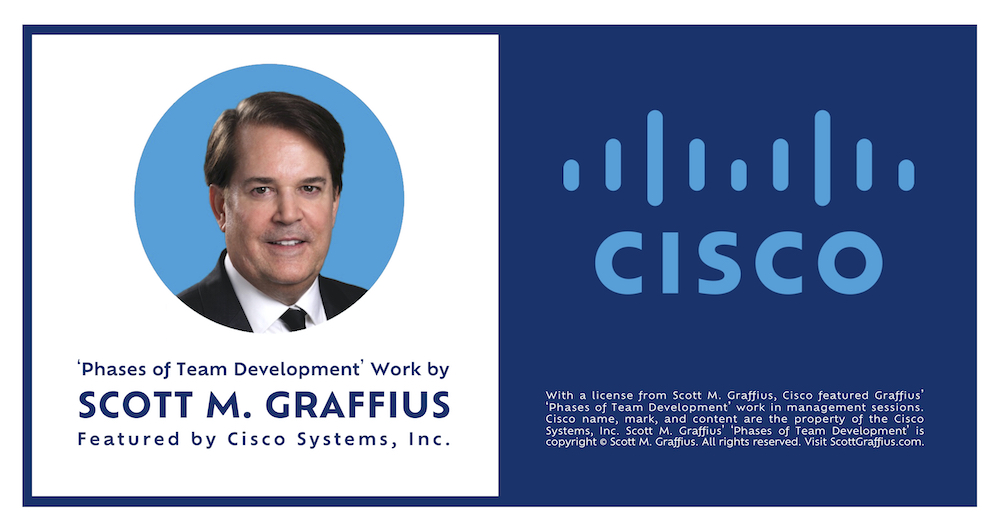










Sign up for Miro—it's free!
(Want more features? You can always upgrade to a paid plan.)


How to Cite This Article
Graffius, Scott M. (2025, January 24). When Agile, AI, and Strategic Thinking Converge. Available at: https://scottgraffius.com/blog/files/when-agile-ai-and-strategic-thinking-converge.html. 

Digital Object Identifier (DOI)
DOI: 10.13140/RG.2.2.22277.46565

Short Link for Article
The short link for this article is https://bit.ly/ai-agile

Copyright
Copyright © Scott M. Graffius. All rights reserved.
Content on this site—including text, images, videos, and data—may not be used for training or input into any artificial intelligence, machine learning, or automatized learning systems, or published, broadcast, rewritten, or redistributed without the express written permission of Scott M. Graffius.
